MyBatis 是支持定制化 SQL、存储过程以及高级 映射的优秀的持久层框架。
• MyBatis 避免了几乎所有的 JDBC 代码和手动设 置参数以及获取结果集。
• MyBatis可以使用简单的XML或注解用于配置和原 始映射,将接口和Java的POJO(Plain Old Java Objects,普通的Java对象)映射成数据库中的记 录
原是Apache的一个开源项目iBatis, 2010年6月这 个项目由Apache Software Foundation 迁移到了 Google Code,随着开发团队转投Google Code 旗下, iBatis3.x正式更名为MyBatis ,代码于 2013年11月迁移到Github(下载地址见后)。
• iBatis一词来源于“internet”和“abatis”的组合,是
一个基于Java的持久层框架。 iBatis提供的持久 层框架包括SQL Maps和Data Access Objects (DAO)MyBatis是一个半自动化的持久化层框架。
• JDBC
– SQL夹在Java代码块里,耦合度高导致硬编码内伤
– 维护不易且实际开发需求中sql是有变化,频繁修改的情况多见
• Hibernate和JPA
– 长难复杂SQL,对于Hibernate而言处理也不容易
– 内部自动生产的SQL,不容易做特殊优化。
– 基于全映射的全自动框架,大量字段的POJO进行部分映射时比较困难。 导致数据库性能下降。
• 对开发人员而言,核心sql还是需要自己优化
• sql和java编码分开,功能边界清晰,一个专注业务、 一个专注数据。
SqlSession
• SqlSession 的实例不是线程安全的,因此是不能 被共享的。
• SqlSession每次使用完成后需要正确关闭,这个 关闭操作是必须的
• SqlSession可以直接调用方法的id进行数据库操 作,但是我们一般还是推荐使用SqlSession获取 到Dao接口的代理类,执行代理对象的方法,可 以更安全的进行类型检查操作
全局配置的标签讲解:
properties属性:
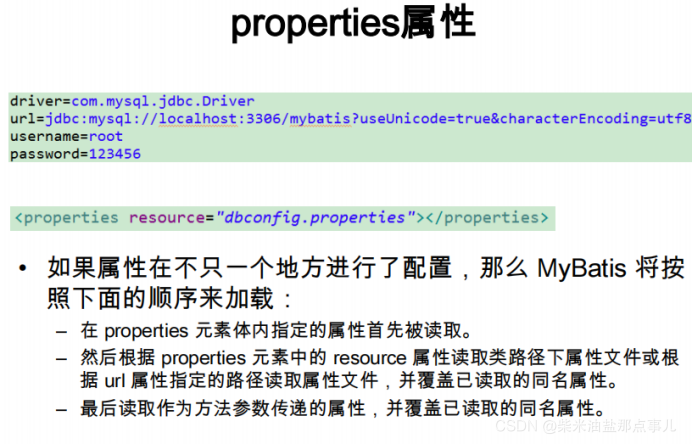
Settings

typeAliases
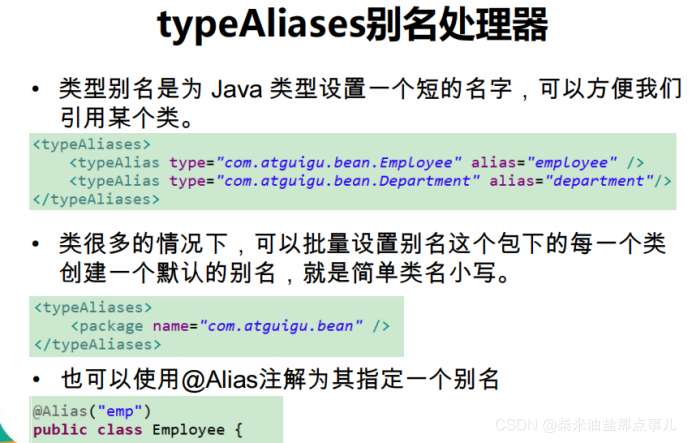
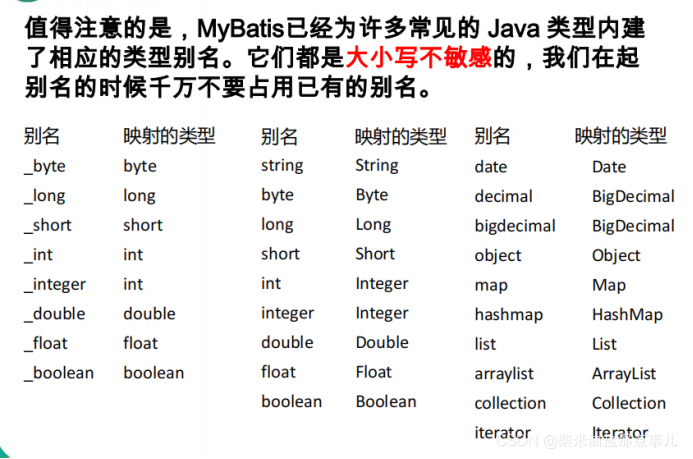
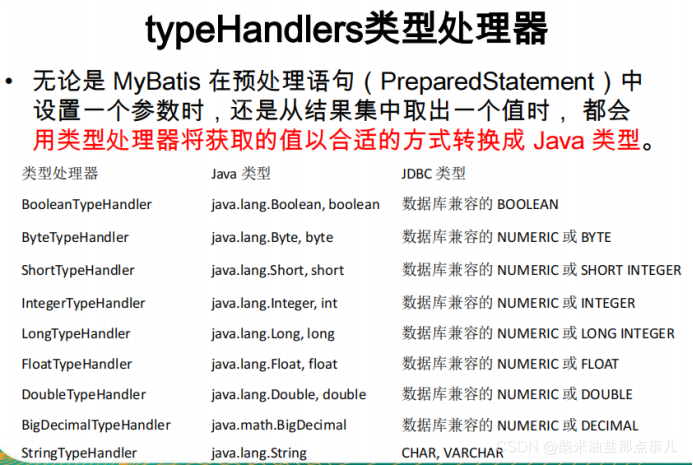
plugins插件
插件是MyBatis提供的一个非常强大的机制,我们
可以通过插件来修改MyBatis的一些核心行为。插
件通过动态代理机制,可以介入四大对象的任何
一个方法的执行。后面会有专门的章节我们来介
绍mybatis运行原理以及插件
• Executor (update, query, flushStatements, commit, rollback,
getTransaction, close, isClosed)
• ParameterHandler (getParameterObject, setParameters)
• ResultSetHandler (handleResultSets, handleOutputParameters)
• StatementHandler (prepare, parameterize, batch, update, query)
environments环境
• MyBatis可以配置多种环境,比如开发、测试和生
产环境需要有不同的配置。
• 每种环境使用一个environment标签进行配置并指
定唯一标识符
• 可以通过environments标签中的default属性指定
一个环境的标识符来快速的切换环境
environment-指定具体环境
• id:指定当前环境的唯一标识
• transactionManager、和dataSource都必须有
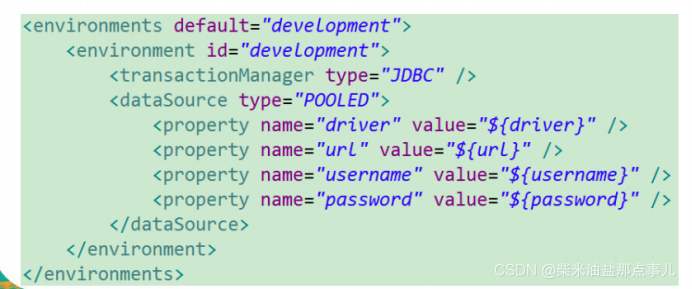
transactionManager
• type: JDBC | MANAGED | 自定义
– JDBC:使用了 JDBC 的提交和回滚设置,依赖于从数
据源得到的连接来管理事务范围。
JdbcTransactionFactory
– MANAGED:不提交或回滚一个连接、让容器来管理
事务的整个生命周期(比如 JEE 应用服务器的上下
文)。 ManagedTransactionFactory
– 自定义:实现TransactionFactory接口,type=全类名/
别名
dataSource
• type: UNPOOLED | POOLED | JNDI | 自定义
– UNPOOLED:不使用连接池,
UnpooledDataSourceFactory
– POOLED:使用连接池, PooledDataSourceFactory
– JNDI: 在EJB 或应用服务器这类容器中查找指定的数
据源
– 自定义:实现DataSourceFactory接口,定义数据源的
获取方式。
• 实际开发中我们使用Spring管理数据源,并进行
事务控制的配置来覆盖上述配置
databaseIdProvider环境
MyBatis 可以根据不同的数据库厂商执行不同的语句。

Type: DB_VENDOR
– 使用MyBatis提供的VendorDatabaseIdProvider解析数据库
厂商标识。也可以实现DatabaseIdProvider接口来自定义。
• Property-name:数据库厂商标识
• Property-value:为标识起一个别名,方便SQL语句使用
databaseId属性引用

DB_VENDOR
– 会通过 DatabaseMetaData#getDatabaseProductName() 返回的字符
串进行设置。由于通常情况下这个字符串都非常长而且相同产品的不
同版本会返回不同的值,所以最好通过设置属性别名来使其变短
• MyBatis匹配规则如下:
– 1、如果没有配置databaseIdProvider标签,那么databaseId=null
– 2、如果配置了databaseIdProvider标签,使用标签配置的name去匹
配数据库信息,匹配上设置databaseId=配置指定的值,否则依旧为 null
– 3、如果databaseId不为null,他只会找到配置databaseId的sql语句
– 4、MyBatis 会加载不带 databaseId 属性和带有匹配当前数据库
databaseId 属性的所有语句。如果同时找到带有 databaseId 和不带
databaseId 的相同语句,则后者会被舍弃。
mapper映射
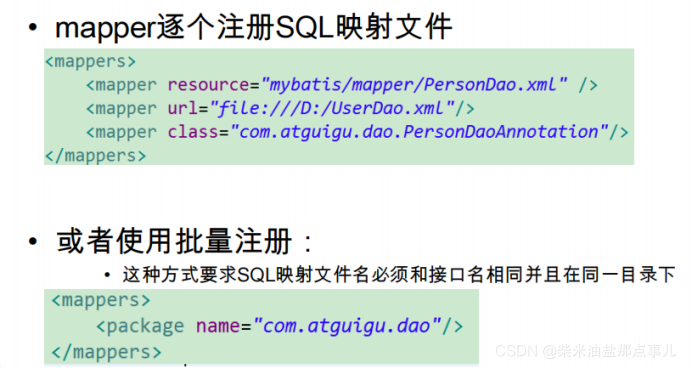
<?xml version="1.0" encoding="UTF-8" ?>
<!DOCTYPE configuration
PUBLIC "-//mybatis.org//DTD Config 3.0//EN"
"http://mybatis.org/dtd/mybatis-3-config.dtd">
<configuration>
<!--
1、mybatis可以使用properties来引入外部properties配置文件的内容;
resource:引入类路径下的资源
url:引入网络路径或者磁盘路径下的资源
-->
<properties resource="dbconfig.properties"></properties>
<!--
2、settings包含很多重要的设置项
setting:用来设置每一个设置项
name:设置项名
value:设置项取值
-->
<settings>
<setting name="mapUnderscoreToCamelCase" value="true"/>
</settings>
<!-- 3、typeAliases:别名处理器:可以为我们的java类型起别名
别名不区分大小写
-->
<typeAliases>
<!-- 1、typeAlias:为某个java类型起别名
type:指定要起别名的类型全类名;默认别名就是类名小写;employee
alias:指定新的别名
-->
<!-- <typeAlias type="com.atguigu.mybatis.bean.Employee" alias="emp"/> -->
<!-- 2、package:为某个包下的所有类批量起别名
name:指定包名(为当前包以及下面所有的后代包的每一个类都起一个默认别名(类名小写),)
-->
<package name="com.atguigu.mybatis.bean"/>
<!-- 3、批量起别名的情况下,使用@Alias注解为某个类型指定新的别名 -->
</typeAliases>
<!--
4、environments:环境们,mybatis可以配置多种环境 ,default指定使用某种环境。可以达到快速切换环境。
environment:配置一个具体的环境信息;必须有两个标签;id代表当前环境的唯一标识
transactionManager:事务管理器;
type:事务管理器的类型;JDBC(JdbcTransactionFactory)|MANAGED(ManagedTransactionFactory)
自定义事务管理器:实现TransactionFactory接口.type指定为全类名
dataSource:数据源;
type:数据源类型;UNPOOLED(UnpooledDataSourceFactory)
|POOLED(PooledDataSourceFactory)
|JNDI(JndiDataSourceFactory)
自定义数据源:实现DataSourceFactory接口,type是全类名
-->
<environments default="dev_mysql">
<environment id="dev_mysql">
<transactionManager type="JDBC"></transactionManager>
<dataSource type="POOLED">
<property name="driver" value="${jdbc.driver}" />
<property name="url" value="${jdbc.url}" />
<property name="username" value="${jdbc.username}" />
<property name="password" value="${jdbc.password}" />
</dataSource>
</environment>
<environment id="dev_oracle">
<transactionManager type="JDBC" />
<dataSource type="POOLED">
<property name="driver" value="${orcl.driver}" />
<property name="url" value="${orcl.url}" />
<property name="username" value="${orcl.username}" />
<property name="password" value="${orcl.password}" />
</dataSource>
</environment>
</environments>
<!-- 5、databaseIdProvider:支持多数据库厂商的;
type="DB_VENDOR":VendorDatabaseIdProvider
作用就是得到数据库厂商的标识(驱动getDatabaseProductName()),mybatis就能根据数据库厂商标识来执行不同的sql;
MySQL,Oracle,SQL Server,xxxx
-->
<databaseIdProvider type="DB_VENDOR">
<!-- 为不同的数据库厂商起别名 -->
<property name="MySQL" value="mysql"/>
<property name="Oracle" value="oracle"/>
<property name="SQL Server" value="sqlserver"/>
</databaseIdProvider>
<!-- 将我们写好的sql映射文件(EmployeeMapper.xml)一定要注册到全局配置文件(mybatis-config.xml)中 -->
<!-- 6、mappers:将sql映射注册到全局配置中 -->
<mappers>
<!--
mapper:注册一个sql映射
注册配置文件
resource:引用类路径下的sql映射文件
mybatis/mapper/EmployeeMapper.xml
url:引用网路路径或者磁盘路径下的sql映射文件
file:///var/mappers/AuthorMapper.xml
注册接口
class:引用(注册)接口,
1、有sql映射文件,映射文件名必须和接口同名,并且放在与接口同一目录下;
2、没有sql映射文件,所有的sql都是利用注解写在接口上;
推荐:
比较重要的,复杂的Dao接口我们来写sql映射文件
不重要,简单的Dao接口为了开发快速可以使用注解;
-->
<!-- <mapper resource="mybatis/mapper/EmployeeMapper.xml"/> -->
<!-- <mapper class="com.atguigu.mybatis.dao.EmployeeMapperAnnotation"/> -->
<!-- 批量注册: -->
<package name="com.atguigu.mybatis.dao"/>
</mappers>
</configuration>
MyBatis-映射文件_增删改查
增删改查:
/**
* 测试增删改
* 1、mybatis允许增删改直接定义以下类型返回值
* Integer、Long、Boolean、void
* 2、我们需要手动提交数据
* sqlSessionFactory.openSession();===》手动提交
* sqlSessionFactory.openSession(true);===》自动提交
* @throws IOException
*/
@Test
public void test03() throws IOException{
// 1、获取sqlSessionFactory对象
SqlSessionFactory sqlSessionFactory = getSqlSessionFactory();
//2、获取到的SqlSession不会自动提交数据
SqlSession openSession = sqlSessionFactory.openSession();
try{
EmployeeMapper mapper = openSession.getMapper(EmployeeMapper.class);
//测试添加
Employee employee = new Employee(null, "jerry4",null, "1");
mapper.addEmp(employee);
System.out.println(employee.getId());
//测试修改
//Employee employee = new Employee(1, "Tom", "jerry@atguigu.com", "0");
//boolean updateEmp = mapper.updateEmp(employee);
//System.out.println(updateEmp);
//测试删除
//mapper.deleteEmpById(2);
//2、手动提交数据
openSession.commit();
}finally{
openSession.close();
}
}
《自增主键》-insert
EmployeeMapper.xml案例
<?xml version="1.0" encoding="UTF-8" ?>
<!DOCTYPE mapper
PUBLIC "-//mybatis.org//DTD Mapper 3.0//EN"
"http://mybatis.org/dtd/mybatis-3-mapper.dtd">
<mapper namespace="com.atguigu.mybatis.dao.EmployeeMapper">
<!--
namespace:名称空间;指定为接口的全类名
id:唯一标识
resultType:返回值类型
#{id}:从传递过来的参数中取出id值
public Employee getEmpById(Integer id);
-->
<!--public Map<Integer, Employee> getEmpByLastNameLikeReturnMap(String lastName); -->
<select id="getEmpByLastNameLikeReturnMap" resultType="com.atguigu.mybatis.bean.Employee">
select * from tbl_employee where last_name like #{lastName}
</select>
<!--public Map<String, Object> getEmpByIdReturnMap(Integer id); -->
<select id="getEmpByIdReturnMap" resultType="map">
select * from tbl_employee where id=#{id}
</select>
<!-- public List<Employee> getEmpsByLastNameLike(String lastName); -->
<!--resultType:如果返回的是一个集合,要写集合中元素的类型 -->
<select id="getEmpsByLastNameLike" resultType="com.atguigu.mybatis.bean.Employee">
select * from tbl_employee where last_name like #{lastName}
</select>
<!-- public Employee getEmpByMap(Map<String, Object> map); -->
<select id="getEmpByMap" resultType="com.atguigu.mybatis.bean.Employee">
select * from ${tableName} where id=${id} and last_name=#{lastName}
</select>
<!-- public Employee getEmpByIdAndLastName(Integer id,String lastName);-->
<select id="getEmpByIdAndLastName" resultType="com.atguigu.mybatis.bean.Employee">
select * from tbl_employee where id = #{id} and last_name=#{lastName}
</select>
<select id="getEmpById" resultType="com.atguigu.mybatis.bean.Employee">
select * from tbl_employee where id = #{id}
</select>
<select id="getEmpById" resultType="com.atguigu.mybatis.bean.Employee"
databaseId="mysql">
select * from tbl_employee where id = #{id}
</select>
<select id="getEmpById" resultType="com.atguigu.mybatis.bean.Employee"
databaseId="oracle">
select EMPLOYEE_ID id,LAST_NAME lastName,EMAIL email
from employees where EMPLOYEE_ID=#{id}
</select>
<!-- public void addEmp(Employee employee); -->
<!-- parameterType:参数类型,可以省略,
获取自增主键的值:
mysql支持自增主键,自增主键值的获取,mybatis也是利用statement.getGenreatedKeys();
useGeneratedKeys="true";使用自增主键获取主键值策略
keyProperty;指定对应的主键属性,也就是mybatis获取到主键值以后,将这个值封装给javaBean的哪个属性
-->
<insert id="addEmp" parameterType="com.atguigu.mybatis.bean.Employee"
useGeneratedKeys="true" keyProperty="id" databaseId="mysql">
insert into tbl_employee(last_name,email,gender)
values(#{lastName},#{email},#{gender})
</insert>
<!--
获取非自增主键的值:
Oracle不支持自增;Oracle使用序列来模拟自增;
每次插入的数据的主键是从序列中拿到的值;如何获取到这个值;
-->
<insert id="addEmp" databaseId="oracle">
<!--
keyProperty:查出的主键值封装给javaBean的哪个属性
order="BEFORE":当前sql在插入sql之前运行
AFTER:当前sql在插入sql之后运行
resultType:查出的数据的返回值类型
BEFORE运行顺序:
先运行selectKey查询id的sql;查出id值封装给javaBean的id属性
在运行插入的sql;就可以取出id属性对应的值
AFTER运行顺序:
先运行插入的sql(从序列中取出新值作为id);
再运行selectKey查询id的sql;
-->
<selectKey keyProperty="id" order="BEFORE" resultType="Integer">
<!-- 编写查询主键的sql语句 -->
<!-- BEFORE-->
select EMPLOYEES_SEQ.nextval from dual
<!-- AFTER:
select EMPLOYEES_SEQ.currval from dual -->
</selectKey>
<!-- 插入时的主键是从序列中拿到的 -->
<!-- BEFORE:-->
insert into employees(EMPLOYEE_ID,LAST_NAME,EMAIL)
values(#{id},#{lastName},#{email<!-- ,jdbcType=NULL -->})
<!-- AFTER:
insert into employees(EMPLOYEE_ID,LAST_NAME,EMAIL)
values(employees_seq.nextval,#{lastName},#{email}) -->
</insert>
<!-- public void updateEmp(Employee employee); -->
<update id="updateEmp">
update tbl_employee
set last_name=#{lastName},email=#{email},gender=#{gender}
where id=#{id}
</update>
<!-- public void deleteEmpById(Integer id); -->
<delete id="deleteEmpById">
delete from tbl_employee where id=#{id}
</delete>
</mapper>
返回数据封装成 List和map类型
MyBatisTest.java
//map和list的方式
@Test
public void test04() throws IOException{
SqlSessionFactory sqlSessionFactory = getSqlSessionFactory();
//1、获取到的SqlSession不会自动提交数据
SqlSession openSession = sqlSessionFactory.openSession();
try{
EmployeeMapper mapper = openSession.getMapper(EmployeeMapper.class);
//Employee employee = mapper.getEmpByIdAndLastName(1, "tom");
Map<String, Object> map = new HashMap<>();
map.put("id", 2);
map.put("lastName", "Tom");
map.put("tableName", "tbl_employee");
Employee employee = mapper.getEmpByMap(map);
System.out.println(employee);
//list返回集合 这里注意EmployeeMapper.java里面的该方法
/*List<Employee> like = mapper.getEmpsByLastNameLike("%e%");
for (Employee employee : like) {
System.out.println(employee);
}*/
//map 这里注意EmployeeMapper.java里面的该方法
/*Map<String, Object> map = mapper.getEmpByIdReturnMap(1);
System.out.println(map);*/
/*Map<String, Employee> map = mapper.getEmpByLastNameLikeReturnMap("%r%");
System.out.println(map);*/
}finally{
openSession.close();
}
}
EmployeeMapper.java
package com.atguigu.mybatis.dao;
import java.util.List;
import java.util.Map;
import org.apache.ibatis.annotations.MapKey;
import org.apache.ibatis.annotations.Param;
import com.atguigu.mybatis.bean.Employee;
public interface EmployeeMapper {
//多条记录封装一个map:Map<Integer,Employee>:键是这条记录的主键,值是记录封装后的javaBean
//@MapKey:告诉mybatis封装这个map的时候使用哪个属性作为map的key
@MapKey("lastName")
public Map<String, Employee> getEmpByLastNameLikeReturnMap(String lastName);
//返回一条记录的map;key就是列名,值就是对应的值
public Map<String, Object> getEmpByIdReturnMap(Integer id);
public List<Employee> getEmpsByLastNameLike(String lastName);
public Employee getEmpByMap(Map<String, Object> map);
}
EmployeeMapper.xml
<!--public Map<Integer, Employee> getEmpByLastNameLikeReturnMap(String lastName); -->
<select id="getEmpByLastNameLikeReturnMap" resultType="com.atguigu.mybatis.bean.Employee">
select * from tbl_employee where last_name like #{lastName}
</select>
<!--public Map<String, Object> getEmpByIdReturnMap(Integer id); -->
<select id="getEmpByIdReturnMap" resultType="map">
select * from tbl_employee where id=#{id}
</select>
<!-- public List<Employee> getEmpsByLastNameLike(String lastName); -->
<!--resultType:如果返回的是一个集合,要写集合中元素的类型 !!!!! -->
<select id="getEmpsByLastNameLike" resultType="com.atguigu.mybatis.bean.Employee">
select * from tbl_employee where last_name like #{lastName}
</select>
<!-- public Employee getEmpByMap(Map<String, Object> map); -->
<select id="getEmpByMap" resultType="com.atguigu.mybatis.bean.Employee">
select * from ${tableName} where id=${id} and last_name=#{lastName}
</select>
<!-- public Employee getEmpByIdAndLastName(Integer id,String lastName);-->
<select id="getEmpByIdAndLastName" resultType="com.atguigu.mybatis.bean.Employee">
select * from tbl_employee where id = #{id} and last_name=#{lastName}
</select>
一些属性的用法
目录
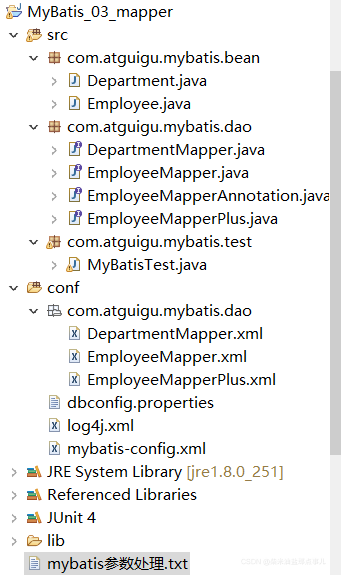
Department.java
package com.atguigu.mybatis.bean;
import java.util.List;
public class Department {
private Integer id;
private String departmentName;
private List<Employee> emps;
public List<Employee> getEmps() {
return emps;
}
public void setEmps(List<Employee> emps) {
this.emps = emps;
}
public Integer getId() {
return id;
}
public void setId(Integer id) {
this.id = id;
}
public String getDepartmentName() {
return departmentName;
}
public void setDepartmentName(String departmentName) {
this.departmentName = departmentName;
}
@Override
public String toString() {
return "Department [id=" + id + ", departmentName=" + departmentName
+ "]";
}
}
Employee.java
package com.atguigu.mybatis.bean;
import org.apache.ibatis.type.Alias;
@Alias("emp")
public class Employee {
private Integer id;
private String lastName;
private String email;
private String gender;
private Department dept;
public Employee() {
super();
}
public Employee(Integer id, String lastName, String email, String gender) {
super();
this.id = id;
this.lastName = lastName;
this.email = email;
this.gender = gender;
}
public Department getDept() {
return dept;
}
public void setDept(Department dept) {
this.dept = dept;
}
public Integer getId() {
return id;
}
public void setId(Integer id) {
this.id = id;
}
public String getLastName() {
return lastName;
}
public void setLastName(String lastName) {
this.lastName = lastName;
}
public String getEmail() {
return email;
}
public void setEmail(String email) {
this.email = email;
}
public String getGender() {
return gender;
}
public void setGender(String gender) {
this.gender = gender;
}
@Override
public String toString() {
return "Employee [id=" + id + ", lastName=" + lastName + ", email="
+ email + ", gender=" + gender + "]";
}
}
EmployeeMapperPlus.java
package com.atguigu.mybatis.dao;
import java.util.List;
import com.atguigu.mybatis.bean.Employee;
public interface EmployeeMapperPlus {
public Employee getEmpById(Integer id);
public Employee getEmpAndDept(Integer id);
public Employee getEmpByIdStep(Integer id);
public List<Employee> getEmpsByDeptId(Integer deptId);
}
DepartmentMapper.java
package com.atguigu.mybatis.dao;
import com.atguigu.mybatis.bean.Department;
public interface DepartmentMapper {
public Department getDeptById(Integer id);
public Department getDeptByIdPlus(Integer id);
public Department getDeptByIdStep(Integer id);
}
DepartmentMapper.xml
<?xml version="1.0" encoding="UTF-8"?>
<!DOCTYPE mapper
PUBLIC "-//mybatis.org//DTD Mapper 3.0//EN"
"http://mybatis.org/dtd/mybatis-3-mapper.dtd">
<mapper namespace="com.atguigu.mybatis.dao.DepartmentMapper">
<!--public Department getDeptById(Integer id); -->
<select id="getDeptById" resultType="com.atguigu.mybatis.bean.Department">
select id,dept_name departmentName from tbl_dept where id=#{id}
</select>
<!--
public class Department {
private Integer id;
private String departmentName;
private List<Employee> emps;
did dept_name || eid last_name email gender
-->
<!--嵌套结果集的方式,使用collection标签定义关联的集合类型的属性封装规则 -->
<resultMap type="com.atguigu.mybatis.bean.Department" id="MyDept">
<id column="did" property="id"/>
<result column="dept_name" property="departmentName"/>
<!--
collection定义关联集合类型的属性的封装规则
ofType:指定集合里面元素的类型
-->
<collection property="emps" ofType="com.atguigu.mybatis.bean.Employee">
<!-- 定义这个集合中元素的封装规则 -->
<id column="eid" property="id"/>
<result column="last_name" property="lastName"/>
<result column="email" property="email"/>
<result column="gender" property="gender"/>
</collection>
</resultMap>
<!-- public Department getDeptByIdPlus(Integer id); -->
<select id="getDeptByIdPlus" resultMap="MyDept">
SELECT d.id did,d.dept_name dept_name,
e.id eid,e.last_name last_name,e.email email,e.gender gender
FROM tbl_dept d
LEFT JOIN tbl_employee e
ON d.id=e.d_id
WHERE d.id=#{id}
</select>
<!-- collection:分段查询 -->
<resultMap type="com.atguigu.mybatis.bean.Department" id="MyDeptStep">
<id column="id" property="id"/>
<id column="dept_name" property="departmentName"/>
<collection property="emps"
select="com.atguigu.mybatis.dao.EmployeeMapperPlus.getEmpsByDeptId"
column="{deptId=id}" fetchType="lazy"></collection>
</resultMap>
<!-- public Department getDeptByIdStep(Integer id); -->
<select id="getDeptByIdStep" resultMap="MyDeptStep">
select id,dept_name from tbl_dept where id=#{id}
</select>
<!-- 扩展:多列的值传递过去:
将多列的值封装map传递;
column="{key1=column1,key2=column2}"
fetchType="lazy":表示使用延迟加载;
- lazy:延迟
- eager:立即
-->
</mapper>
EmployeeMapperPlus.xml
<?xml version="1.0" encoding="UTF-8"?>
<!DOCTYPE mapper
PUBLIC "-//mybatis.org//DTD Mapper 3.0//EN"
"http://mybatis.org/dtd/mybatis-3-mapper.dtd">
<mapper namespace="com.atguigu.mybatis.dao.EmployeeMapperPlus">
<!--自定义某个javaBean的封装规则
type:自定义规则的Java类型
id:唯一id方便引用
-->
<resultMap type="com.atguigu.mybatis.bean.Employee" id="MySimpleEmp">
<!--指定主键列的封装规则
id定义主键会底层有优化;
column:指定哪一列
property:指定对应的javaBean属性
-->
<id column="id" property="id"/>
<!-- 定义普通列封装规则 -->
<result column="last_name" property="lastName"/>
<!-- 其他不指定的列会自动封装:我们只要写resultMap就把全部的映射规则都写上。 -->
<result column="email" property="email"/>
<result column="gender" property="gender"/>
</resultMap>
<!-- resultMap:自定义结果集映射规则; -->
<!-- public Employee getEmpById(Integer id); -->
<select id="getEmpById" resultMap="MySimpleEmp">
select * from tbl_employee where id=#{id}
</select>
<!--
场景一:
查询Employee的同时查询员工对应的部门
Employee===Department
一个员工有与之对应的部门信息;
id last_name gender d_id did dept_name (private Department dept;)
-->
<!--
联合查询:级联属性封装结果集
-->
<resultMap type="com.atguigu.mybatis.bean.Employee" id="MyDifEmp">
<id column="id" property="id"/>
<result column="last_name" property="lastName"/>
<result column="gender" property="gender"/>
<result column="did" property="dept.id"/>
<result column="dept_name" property="dept.departmentName"/>
</resultMap>
<!--
使用association定义关联的单个对象的封装规则;
-->
<resultMap type="com.atguigu.mybatis.bean.Employee" id="MyDifEmp2">
<id column="id" property="id"/>
<result column="last_name" property="lastName"/>
<result column="gender" property="gender"/>
<!-- association可以指定联合的javaBean对象
property="dept":指定哪个属性是联合的对象
javaType:指定这个属性对象的类型[不能省略]
-->
<association property="dept" javaType="com.atguigu.mybatis.bean.Department">
<id column="did" property="id"/>
<result column="dept_name" property="departmentName"/>
</association>
</resultMap>
<!-- public Employee getEmpAndDept(Integer id);-->
<select id="getEmpAndDept" resultMap="MyDifEmp">
SELECT e.id id,e.last_name last_name,e.gender gender,e.d_id d_id,
d.id did,d.dept_name dept_name FROM tbl_employee e,tbl_dept d
WHERE e.d_id=d.id AND e.id=#{id}
</select>
<!-- 使用association进行分步查询:
1、先按照员工id查询员工信息
2、根据查询员工信息中的d_id值去部门表查出部门信息
3、部门设置到员工中;
-->
<!-- id last_name email gender d_id -->
<resultMap type="com.atguigu.mybatis.bean.Employee" id="MyEmpByStep">
<id column="id" property="id"/>
<result column="last_name" property="lastName"/>
<result column="email" property="email"/>
<result column="gender" property="gender"/>
<!-- association定义关联对象的封装规则
select:表明当前属性是调用select指定的方法查出的结果
column:指定将哪一列的值传给这个方法
流程:使用select指定的方法(传入column指定的这列参数的值)查出对象,并封装给property指定的属性
-->
<association property="dept"
select="com.atguigu.mybatis.dao.DepartmentMapper.getDeptById"
column="d_id">
</association>
</resultMap>
<!-- public Employee getEmpByIdStep(Integer id);-->
<select id="getEmpByIdStep" resultMap="MyEmpByStep">
select * from tbl_employee where id=#{id}
<if test="_parameter!=null">
and 1=1
</if>
</select>
<!-- 可以使用延迟加载(懒加载);(按需加载)
Employee==>Dept:
我们每次查询Employee对象的时候,都将一起查询出来。
部门信息在我们使用的时候再去查询;
分段查询的基础之上加上两个配置:
-->
<!-- ==================association============================ -->
<!--
场景二:
查询部门的时候将部门对应的所有员工信息也查询出来:注释在DepartmentMapper.xml中
-->
<!-- public List<Employee> getEmpsByDeptId(Integer deptId); -->
<select id="getEmpsByDeptId" resultType="com.atguigu.mybatis.bean.Employee">
select * from tbl_employee where d_id=#{deptId}
</select>
<!-- =======================鉴别器============================ -->
<!-- <discriminator javaType=""></discriminator>
鉴别器:mybatis可以使用discriminator判断某列的值,然后根据某列的值改变封装行为
封装Employee:
如果查出的是女生:就把部门信息查询出来,否则不查询;
如果是男生,把last_name这一列的值赋值给email;
-->
<resultMap type="com.atguigu.mybatis.bean.Employee" id="MyEmpDis">
<id column="id" property="id"/>
<result column="last_name" property="lastName"/>
<result column="email" property="email"/>
<result column="gender" property="gender"/>
<!--
column:指定判定的列名
javaType:列值对应的java类型 -->
<discriminator javaType="string" column="gender">
<!--女生 resultType:指定封装的结果类型;不能缺少。/resultMap-->
<case value="0" resultType="com.atguigu.mybatis.bean.Employee">
<association property="dept"
select="com.atguigu.mybatis.dao.DepartmentMapper.getDeptById"
column="d_id">
</association>
</case>
<!--男生 ;如果是男生,把last_name这一列的值赋值给email; -->
<case value="1" resultType="com.atguigu.mybatis.bean.Employee">
<id column="id" property="id"/>
<result column="last_name" property="lastName"/>
<result column="last_name" property="email"/>
<result column="gender" property="gender"/>
</case>
</discriminator>
</resultMap>
</mapper>
mybatis-config.xml
<?xml version="1.0" encoding="UTF-8" ?>
<!DOCTYPE configuration
PUBLIC "-//mybatis.org//DTD Config 3.0//EN"
"http://mybatis.org/dtd/mybatis-3-config.dtd">
<configuration>
<!--
1、mybatis可以使用properties来引入外部properties配置文件的内容;
resource:引入类路径下的资源
url:引入网络路径或者磁盘路径下的资源
-->
<properties resource="dbconfig.properties"></properties>
<!--
2、settings包含很多重要的设置项
setting:用来设置每一个设置项
name:设置项名
value:设置项取值
-->
<settings>
<!-- <setting name="mapUnderscoreToCamelCase" value="true"/> -->
<setting name="jdbcTypeForNull" value="NULL"/>
<!--显示的指定每个我们需要更改的配置的值,即使他是默认的。防止版本更新带来的问题 -->
<setting name="lazyLoadingEnabled" value="true"/>
<setting name="aggressiveLazyLoading" value="false"/>
</settings>
<!-- 3、typeAliases:别名处理器:可以为我们的java类型起别名
别名不区分大小写
-->
<typeAliases>
<!-- 1、typeAlias:为某个java类型起别名
type:指定要起别名的类型全类名;默认别名就是类名小写;employee
alias:指定新的别名
-->
<!-- <typeAlias type="com.atguigu.mybatis.bean.Employee" alias="emp"/> -->
<!-- 2、package:为某个包下的所有类批量起别名
name:指定包名(为当前包以及下面所有的后代包的每一个类都起一个默认别名(类名小写),)
-->
<package name="com.atguigu.mybatis.bean"/>
<!-- 3、批量起别名的情况下,使用@Alias注解为某个类型指定新的别名 -->
</typeAliases>
<!--
4、environments:环境们,mybatis可以配置多种环境 ,default指定使用某种环境。可以达到快速切换环境。
environment:配置一个具体的环境信息;必须有两个标签;id代表当前环境的唯一标识
transactionManager:事务管理器;
type:事务管理器的类型;JDBC(JdbcTransactionFactory)|MANAGED(ManagedTransactionFactory)
自定义事务管理器:实现TransactionFactory接口.type指定为全类名
dataSource:数据源;
type:数据源类型;UNPOOLED(UnpooledDataSourceFactory)
|POOLED(PooledDataSourceFactory)
|JNDI(JndiDataSourceFactory)
自定义数据源:实现DataSourceFactory接口,type是全类名
-->
<environments default="dev_mysql">
<environment id="dev_mysql">
<transactionManager type="JDBC"></transactionManager>
<dataSource type="POOLED">
<property name="driver" value="${jdbc.driver}" />
<property name="url" value="${jdbc.url}" />
<property name="username" value="${jdbc.username}" />
<property name="password" value="${jdbc.password}" />
</dataSource>
</environment>
<environment id="dev_oracle">
<transactionManager type="JDBC" />
<dataSource type="POOLED">
<property name="driver" value="${orcl.driver}" />
<property name="url" value="${orcl.url}" />
<property name="username" value="${orcl.username}" />
<property name="password" value="${orcl.password}" />
</dataSource>
</environment>
</environments>
<!-- 5、databaseIdProvider:支持多数据库厂商的;
type="DB_VENDOR":VendorDatabaseIdProvider
作用就是得到数据库厂商的标识(驱动getDatabaseProductName()),mybatis就能根据数据库厂商标识来执行不同的sql;
MySQL,Oracle,SQL Server,xxxx
-->
<databaseIdProvider type="DB_VENDOR">
<!-- 为不同的数据库厂商起别名 -->
<property name="MySQL" value="mysql"/>
<property name="Oracle" value="oracle"/>
<property name="SQL Server" value="sqlserver"/>
</databaseIdProvider>
<!-- 将我们写好的sql映射文件(EmployeeMapper.xml)一定要注册到全局配置文件(mybatis-config.xml)中 -->
<!-- 6、mappers:将sql映射注册到全局配置中 -->
<mappers>
<!--
mapper:注册一个sql映射
注册配置文件
resource:引用类路径下的sql映射文件
mybatis/mapper/EmployeeMapper.xml
url:引用网路路径或者磁盘路径下的sql映射文件
file:///var/mappers/AuthorMapper.xml
注册接口
class:引用(注册)接口,
1、有sql映射文件,映射文件名必须和接口同名,并且放在与接口同一目录下;
2、没有sql映射文件,所有的sql都是利用注解写在接口上;
推荐:
比较重要的,复杂的Dao接口我们来写sql映射文件
不重要,简单的Dao接口为了开发快速可以使用注解;
-->
<!-- <mapper resource="mybatis/mapper/EmployeeMapper.xml"/> -->
<!-- <mapper class="com.atguigu.mybatis.dao.EmployeeMapperAnnotation"/> -->
<!-- 批量注册: -->
<package name="com.atguigu.mybatis.dao"/>
</mappers>
</configuration>
MyBatisTest.java
/*
场景一:
查询Employee的同时查询员工对应的部门
Employee===Department
一个员工有与之对应的部门信息;
id last_name gender d_id did dept_name (private Department dept;)
*/
/*
场景二:
查询部门的时候将部门对应的所有员工信息也查询出来:注释在DepartmentMapper.xml中
*/
/* 延迟加载(懒加载)分段查询的基础之上加上两个配置:
* <setting name="aggressiveLazyLoading" value="false"/>配置文件
*/
/**
* 注意association和collection用法
*/
@Test
public void test05() throws IOException{
SqlSessionFactory sqlSessionFactory = getSqlSessionFactory();
SqlSession openSession = sqlSessionFactory.openSession();
try{
EmployeeMapperPlus mapper = openSession.getMapper(EmployeeMapperPlus.class);
/*Employee empById = mapper.getEmpById(1);
System.out.println(empById);*/
/*Employee empAndDept = mapper.getEmpAndDept(1);
System.out.println(empAndDept);
System.out.println(empAndDept.getDept());*/
Employee employee = mapper.getEmpByIdStep(3);
System.out.println(employee);
//System.out.println(employee.getDept());
System.out.println(employee.getDept());
}finally{
openSession.close();
}
}
/**
*
*从部门入手
*/
@Test
public void test06() throws IOException{
SqlSessionFactory sqlSessionFactory = getSqlSessionFactory();
SqlSession openSession = sqlSessionFactory.openSession();
try{
DepartmentMapper mapper = openSession.getMapper(DepartmentMapper.class);
/*Department department = mapper.getDeptByIdPlus(1);
System.out.println(department);
System.out.println(department.getEmps());*/
Department deptByIdStep = mapper.getDeptByIdStep(1);
System.out.println(deptByIdStep.getDepartmentName());
System.out.println(deptByIdStep.getEmps());
}finally{
openSession.close();
}
}
理论参考
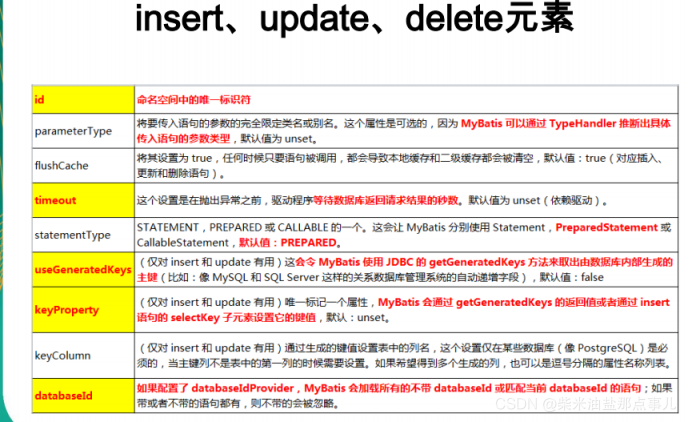
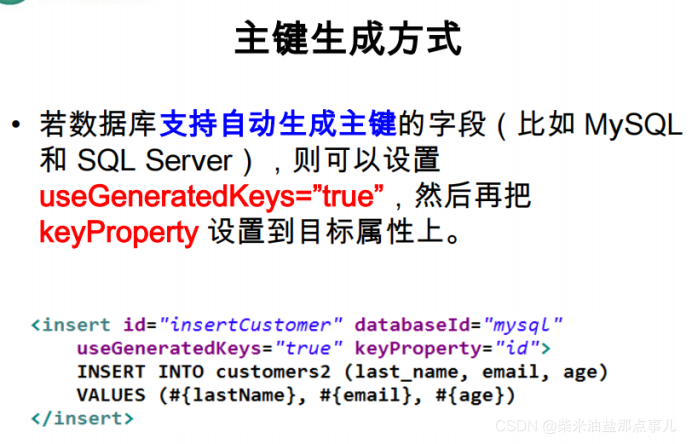
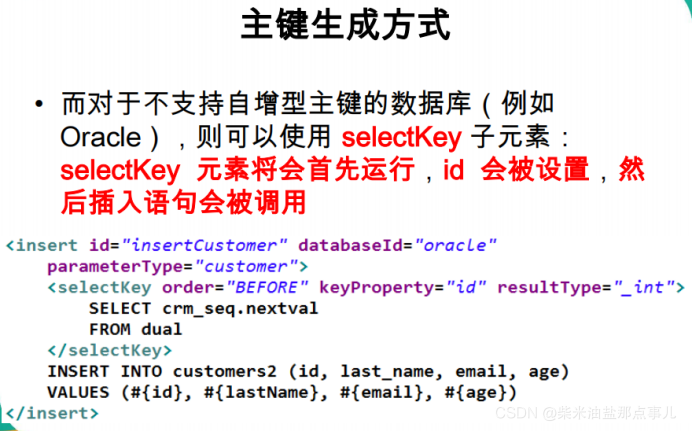
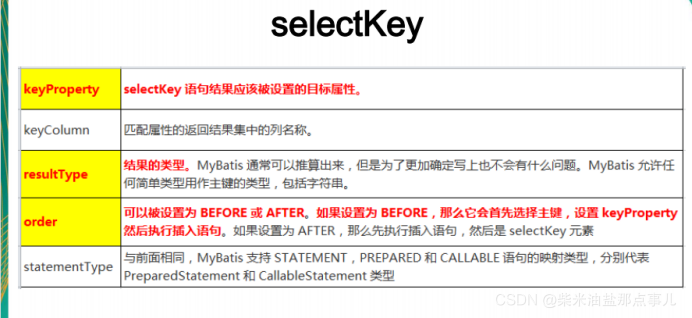
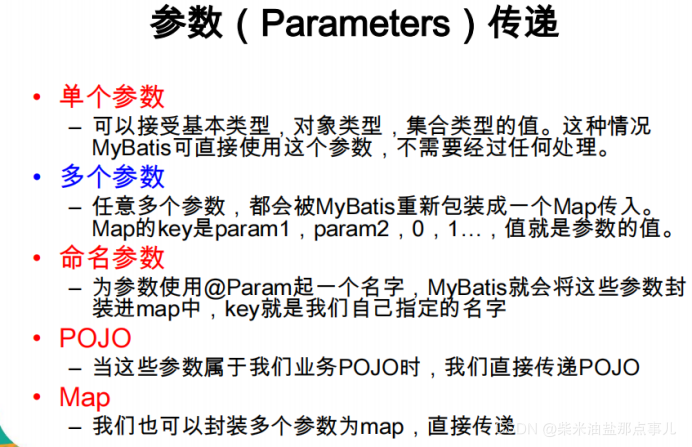
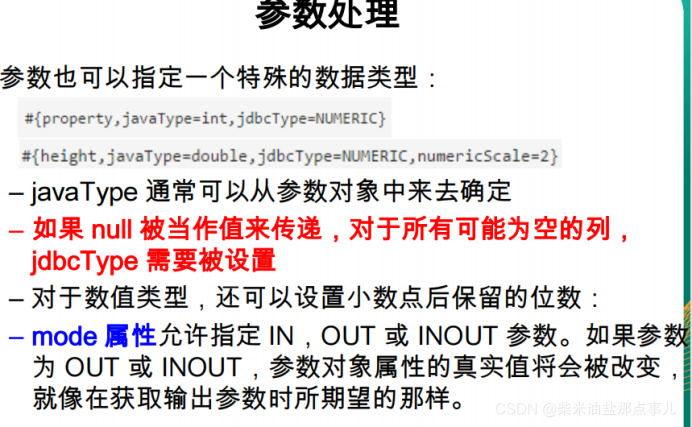
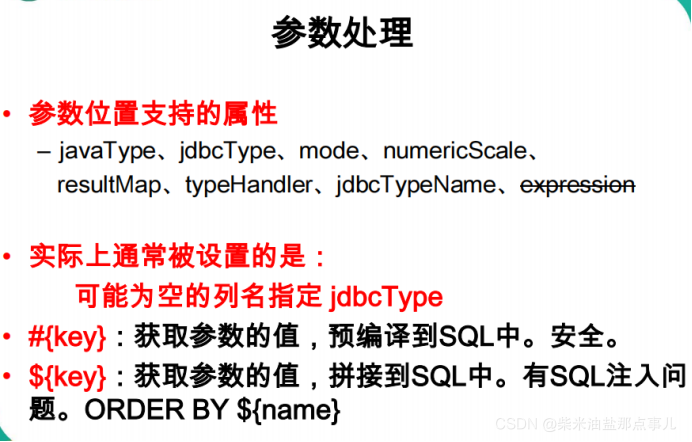
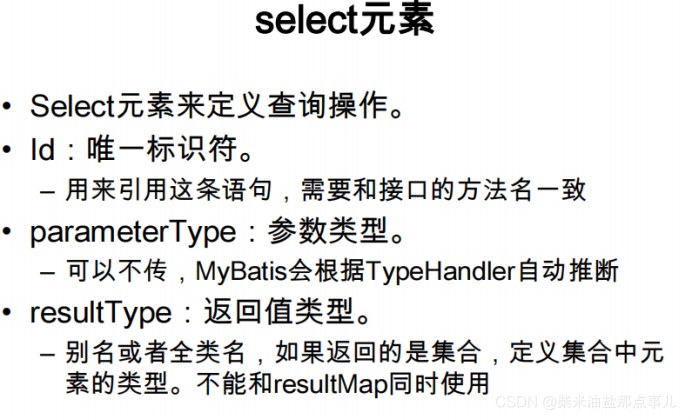
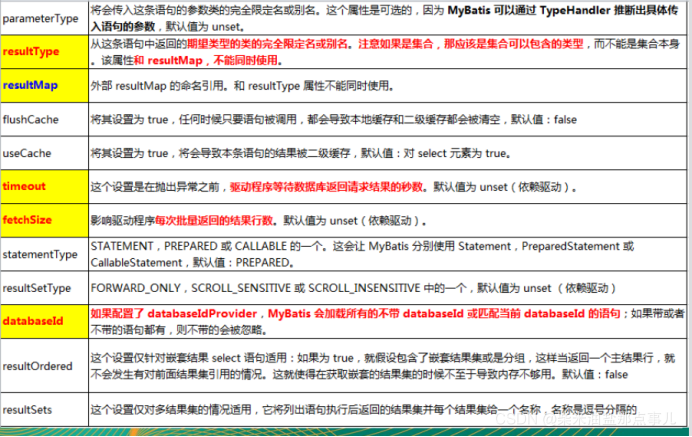
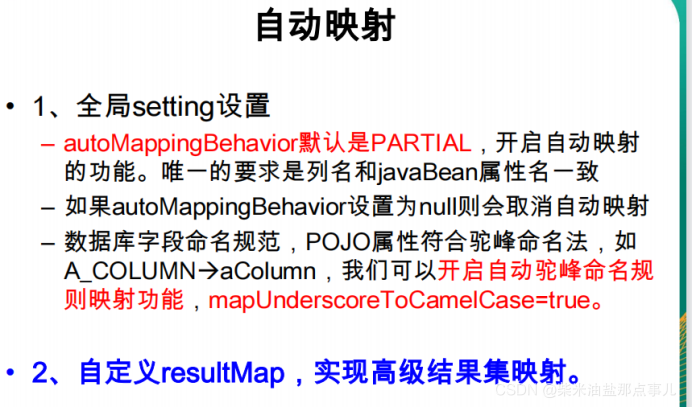
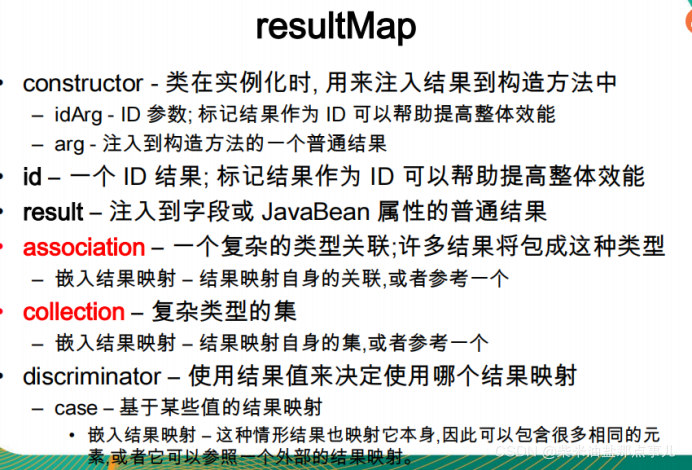
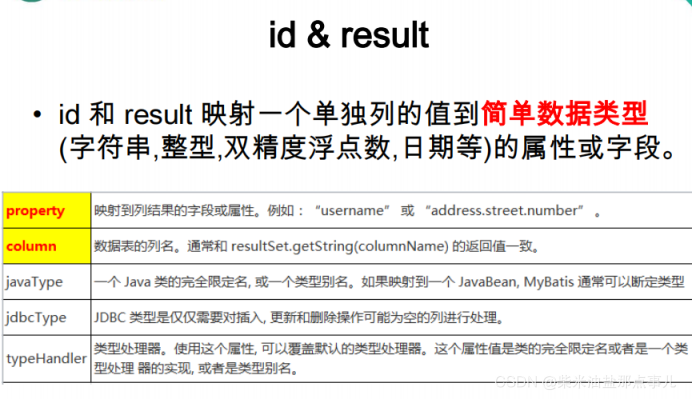
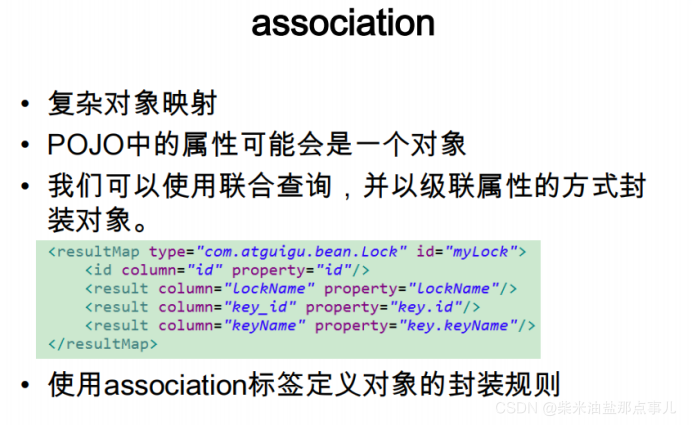
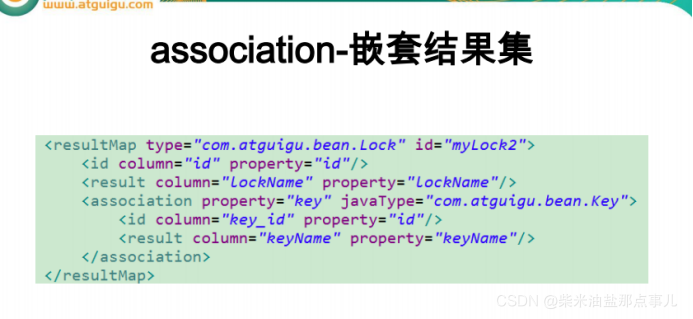
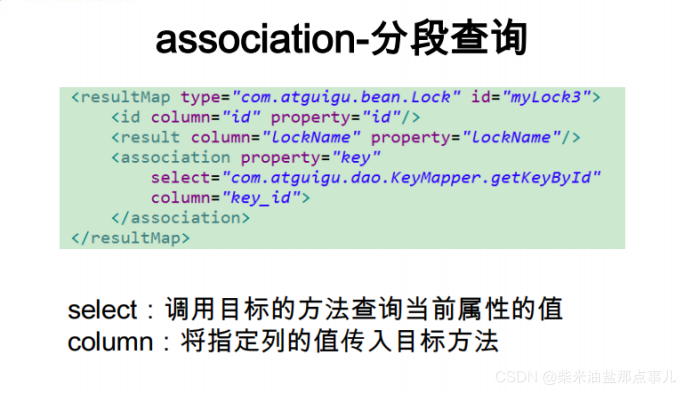
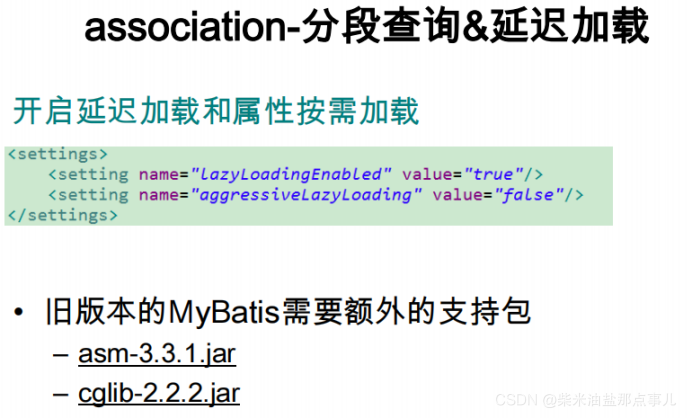
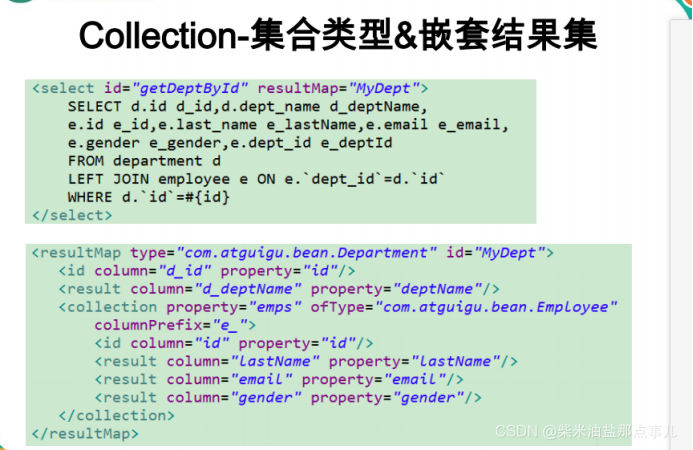
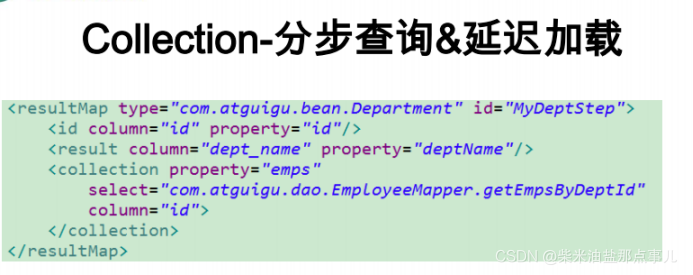
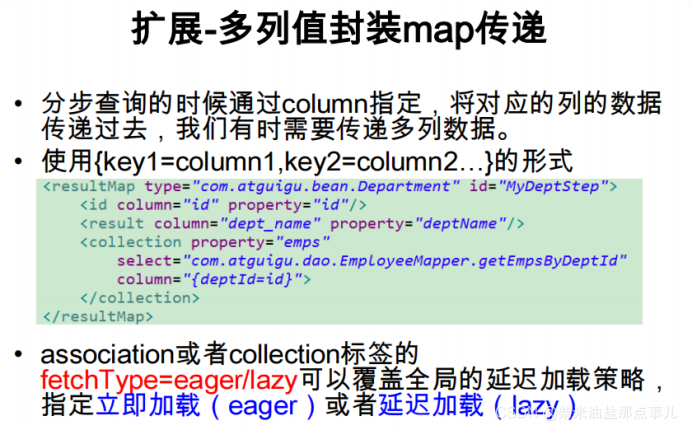
MyBatis-动态SQL
这里直接看代码案例了
一些属性需要注意一下比如_parameter,bind,choose,trim,foreach等等
目录
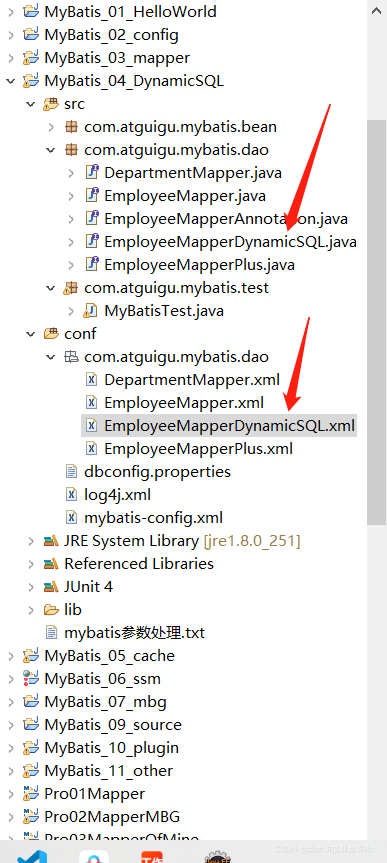
EmployeeMapperDynamicSQL.java
package com.atguigu.mybatis.dao;
import java.util.List;
import org.apache.ibatis.annotations.Param;
import com.atguigu.mybatis.bean.Employee;
public interface EmployeeMapperDynamicSQL {
public List<Employee> getEmpsTestInnerParameter(Employee employee);
//携带了哪个字段查询条件就带上这个字段的值
public List<Employee> getEmpsByConditionIf(Employee employee);
public List<Employee> getEmpsByConditionTrim(Employee employee);
public List<Employee> getEmpsByConditionChoose(Employee employee);
public void updateEmp(Employee employee);
//查询员工id'在给定集合中的
public List<Employee> getEmpsByConditionForeach(@Param("ids")List<Integer> ids);
public void addEmps(@Param("emps")List<Employee> emps);
}
EmployeeMapperDynamicSQL.xml
<?xml version="1.0" encoding="UTF-8"?>
<!DOCTYPE mapper
PUBLIC "-//mybatis.org//DTD Mapper 3.0//EN"
"http://mybatis.org/dtd/mybatis-3-mapper.dtd">
<mapper namespace="com.atguigu.mybatis.dao.EmployeeMapperDynamicSQL">
<!--
• if:判断
• choose (when, otherwise):分支选择;带了break的swtich-case
如果带了id就用id查,如果带了lastName就用lastName查;只会进入其中一个
• trim 字符串截取(where(封装查询条件), set(封装修改条件))
• foreach 遍历集合
-->
<!-- 查询员工,要求,携带了哪个字段查询条件就带上这个字段的值 -->
<!-- public List<Employee> getEmpsByConditionIf(Employee employee); -->
<select id="getEmpsByConditionIf" resultType="com.atguigu.mybatis.bean.Employee">
select * from tbl_employee
<!-- where -->
<where>
<!-- test:判断表达式(OGNL)
OGNL参照PPT或者官方文档。
c:if test
从参数中取值进行判断
遇见特殊符号应该去写转义字符:
&&:
-->
<if test="id!=null">
id=#{id}
</if>
<if test="lastName!=null && lastName!=""">
and last_name like #{lastName}
</if>
<if test="email!=null and email.trim()!=""">
and email=#{email}
</if>
<!-- ognl会进行字符串与数字的转换判断 "0"==0 -->
<if test="gender==0 or gender==1">
and gender=#{gender}
</if>
</where>
</select>
<!--public List<Employee> getEmpsByConditionTrim(Employee employee); -->
<select id="getEmpsByConditionTrim" resultType="com.atguigu.mybatis.bean.Employee">
select * from tbl_employee
<!-- 后面多出的and或者or where标签不能解决
prefix="":前缀:trim标签体中是整个字符串拼串 后的结果。
prefix给拼串后的整个字符串加一个前缀
prefixOverrides="":
前缀覆盖: 去掉整个字符串前面多余的字符
suffix="":后缀
suffix给拼串后的整个字符串加一个后缀
suffixOverrides=""
后缀覆盖:去掉整个字符串后面多余的字符
-->
<!-- 自定义字符串的截取规则 -->
<trim prefix="where" suffixOverrides="and">
<if test="id!=null">
id=#{id} and
</if>
<if test="lastName!=null && lastName!=""">
last_name like #{lastName} and
</if>
<if test="email!=null and email.trim()!=""">
email=#{email} and
</if>
<!-- ognl会进行字符串与数字的转换判断 "0"==0 -->
<if test="gender==0 or gender==1">
gender=#{gender}
</if>
</trim>
</select>
<!-- public List<Employee> getEmpsByConditionChoose(Employee employee); -->
<select id="getEmpsByConditionChoose" resultType="com.atguigu.mybatis.bean.Employee">
select * from tbl_employee
<where>
<!-- 如果带了id就用id查,如果带了lastName就用lastName查;只会进入其中一个 -->
<choose>
<when test="id!=null">
id=#{id}
</when>
<when test="lastName!=null">
last_name like #{lastName}
</when>
<when test="email!=null">
email = #{email}
</when>
<otherwise>
gender = 0
</otherwise>
</choose>
</where>
</select>
<!--public void updateEmp(Employee employee); -->
<update id="updateEmp">
<!-- Set标签的使用 -->
update tbl_employee
<set>
<if test="lastName!=null">
last_name=#{lastName},
</if>
<if test="email!=null">
email=#{email},
</if>
<if test="gender!=null">
gender=#{gender}
</if>
</set>
where id=#{id}
<!--
Trim:更新拼串
update tbl_employee
<trim prefix="set" suffixOverrides=",">
<if test="lastName!=null">
last_name=#{lastName},
</if>
<if test="email!=null">
email=#{email},
</if>
<if test="gender!=null">
gender=#{gender}
</if>
</trim>
where id=#{id} -->
</update>
<!--public List<Employee> getEmpsByConditionForeach(List<Integer> ids); -->
<select id="getEmpsByConditionForeach" resultType="com.atguigu.mybatis.bean.Employee">
select * from tbl_employee
<!--
collection:指定要遍历的集合:
list类型的参数会特殊处理封装在map中,map的key就叫list
item:将当前遍历出的元素赋值给指定的变量
separator:每个元素之间的分隔符
open:遍历出所有结果拼接一个开始的字符
close:遍历出所有结果拼接一个结束的字符
index:索引。遍历list的时候是index就是索引,item就是当前值
遍历map的时候index表示的就是map的key,item就是map的值
#{变量名}就能取出变量的值也就是当前遍历出的元素
-->
<foreach collection="ids" item="item_id" separator=","
open="where id in(" close=")">
#{item_id}
</foreach>
</select>
<!-- 批量保存 -->
<!--public void addEmps(@Param("emps")List<Employee> emps); -->
<!--MySQL下批量保存:可以foreach遍历 mysql支持values(),(),()语法-->
<insert id="addEmps">
insert into tbl_employee(
<include refid="insertColumn"></include>
)
values
<foreach collection="emps" item="emp" separator=",">
(#{emp.lastName},#{emp.email},#{emp.gender},#{emp.dept.id})
</foreach>
</insert><!-- -->
<!-- 这种方式需要数据库连接属性allowMultiQueries=true;
这种分号分隔多个sql可以用于其他的批量操作(删除,修改) -->
<!-- <insert id="addEmps">
<foreach collection="emps" item="emp" separator=";">
insert into tbl_employee(last_name,email,gender,d_id)
values(#{emp.lastName},#{emp.email},#{emp.gender},#{emp.dept.id})
</foreach>
</insert> -->
<!-- Oracle数据库批量保存:
Oracle不支持values(),(),()
Oracle支持的批量方式
1、多个insert放在begin - end里面
begin
insert into employees(employee_id,last_name,email)
values(employees_seq.nextval,'test_001','test_001@atguigu.com');
insert into employees(employee_id,last_name,email)
values(employees_seq.nextval,'test_002','test_002@atguigu.com');
end;
2、利用中间表:
insert into employees(employee_id,last_name,email)
select employees_seq.nextval,lastName,email from(
select 'test_a_01' lastName,'test_a_e01' email from dual
union
select 'test_a_02' lastName,'test_a_e02' email from dual
union
select 'test_a_03' lastName,'test_a_e03' email from dual
)
-->
<insert id="addEmps" databaseId="oracle">
<!-- oracle第一种批量方式 -->
<!-- <foreach collection="emps" item="emp" open="begin" close="end;">
insert into employees(employee_id,last_name,email)
values(employees_seq.nextval,#{emp.lastName},#{emp.email});
</foreach> -->
<!-- oracle第二种批量方式 -->
insert into employees(
<!-- 引用外部定义的sql -->
<include refid="insertColumn">
<property name="testColomn" value="abc"/>
</include>
)
<foreach collection="emps" item="emp" separator="union"
open="select employees_seq.nextval,lastName,email from("
close=")">
select #{emp.lastName} lastName,#{emp.email} email from dual
</foreach>
</insert>
<!-- 两个内置参数:
不只是方法传递过来的参数可以被用来判断,取值。。。
mybatis默认还有两个内置参数:
_parameter:代表整个参数
单个参数:_parameter就是这个参数
多个参数:参数会被封装为一个map;_parameter就是代表这个map
_databaseId:如果配置了databaseIdProvider标签。
_databaseId就是代表当前数据库的别名oracle
-->
<!--public List<Employee> getEmpsTestInnerParameter(Employee employee); -->
<select id="getEmpsTestInnerParameter" resultType="com.atguigu.mybatis.bean.Employee">
<!-- bind用法:可以将OGNL表达式的值绑定到一个变量中,方便后来引用这个变量的值 -->
<bind name="_lastName" value="'%'+lastName+'%'"/>
<if test="_databaseId=='mysql'">
select * from tbl_employee
<if test="_parameter!=null">
where last_name like #{lastName}
</if>
</if>
<if test="_databaseId=='oracle'">
select * from employees
<if test="_parameter!=null">
where last_name like #{_parameter.lastName}
</if>
</if>
</select>
<!--
抽取可重用的sql片段。方便后面引用
1、sql抽取:经常将要查询的列名,或者插入用的列名抽取出来方便引用
2、include来引用已经抽取的sql:
3、include还可以自定义一些property,sql标签内部就能使用自定义的属性
include-property:取值的正确方式${prop},
#{不能使用这种方式}
-->
<sql id="insertColumn">
<if test="_databaseId=='oracle'">
employee_id,last_name,email
</if>
<if test="_databaseId=='mysql'">
last_name,email,gender,d_id
</if>
</sql>
</mapper>
MyBatisTest.java
public SqlSessionFactory getSqlSessionFactory() throws IOException {
String resource = "mybatis-config.xml";
InputStream inputStream = Resources.getResourceAsStream(resource);
return new SqlSessionFactoryBuilder().build(inputStream);
}
@Test
public void testInnerParam() throws IOException{
SqlSessionFactory sqlSessionFactory = getSqlSessionFactory();
SqlSession openSession = sqlSessionFactory.openSession();
try{
EmployeeMapperDynamicSQL mapper = openSession.getMapper(EmployeeMapperDynamicSQL.class);
Employee employee2 = new Employee();
employee2.setLastName("%e%");
List<Employee> list = mapper.getEmpsTestInnerParameter(employee2);
for (Employee employee : list) {
System.out.println(employee);
}
}finally{
openSession.close();
}
}
@Test
public void testBatchSave() throws IOException{
SqlSessionFactory sqlSessionFactory = getSqlSessionFactory();
SqlSession openSession = sqlSessionFactory.openSession();
try{
EmployeeMapperDynamicSQL mapper = openSession.getMapper(EmployeeMapperDynamicSQL.class);
List<Employee> emps = new ArrayList<>();
emps.add(new Employee(null, "smith0x1", "smith0x1@atguigu.com", "1",new Department(1)));
emps.add(new Employee(null, "allen0x1", "allen0x1@atguigu.com", "0",new Department(1)));
mapper.addEmps(emps);
openSession.commit();
}finally{
openSession.close();
}
}
@Test
public void testDynamicSql() throws IOException{
SqlSessionFactory sqlSessionFactory = getSqlSessionFactory();
SqlSession openSession = sqlSessionFactory.openSession();
try{
EmployeeMapperDynamicSQL mapper = openSession.getMapper(EmployeeMapperDynamicSQL.class);
//select * from tbl_employee where id=? and last_name like ?
//测试if\where
Employee employee = new Employee(1, "Admin", null, null);
/* List<Employee> emps = mapper.getEmpsByConditionIf(employee );
for (Employee emp : emps) {
System.out.println(emp);
}*/
//查询的时候如果某些条件没带可能sql拼装会有问题
//1、给where后面加上1=1,以后的条件都and xxx.
//2、mybatis使用where标签来将所有的查询条件包括在内。mybatis就会将where标签中拼装的sql,多出来的and或者or去掉
//where只会去掉第一个多出来的and或者or。
//测试Trim
/*List<Employee> emps2 = mapper.getEmpsByConditionTrim(employee);
for (Employee emp : emps2) {
System.out.println(emp);
}*/
//测试choose
/*List<Employee> list = mapper.getEmpsByConditionChoose(employee);
for (Employee emp : list) {
System.out.println(emp);
}*/
//测试set标签
/*mapper.updateEmp(employee);
openSession.commit();*/
List<Employee> list = mapper.getEmpsByConditionForeach(Arrays.asList(1,2));
for (Employee emp : list) {
System.out.println(emp);
}
}finally{
openSession.close();
}
}
理论
动态 SQL是MyBatis强大特性之一。极大的简化我们拼装
SQL的操作。
• 动态 SQL 元素和使用 JSTL 或其他类似基于 XML 的文本处
理器相似。
• MyBatis 采用功能强大的基于 OGNL 的表达式来简化操作。
– if
– choose (when, otherwise)
– trim (where, set)
– foreach
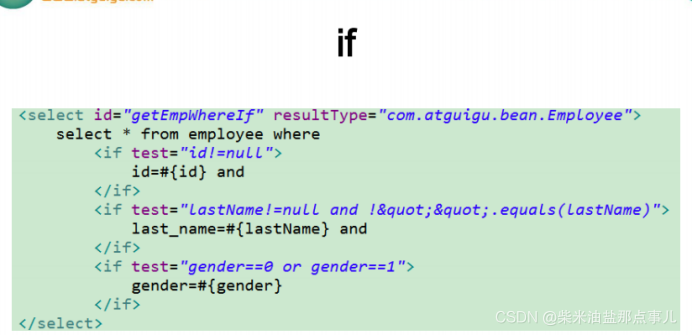
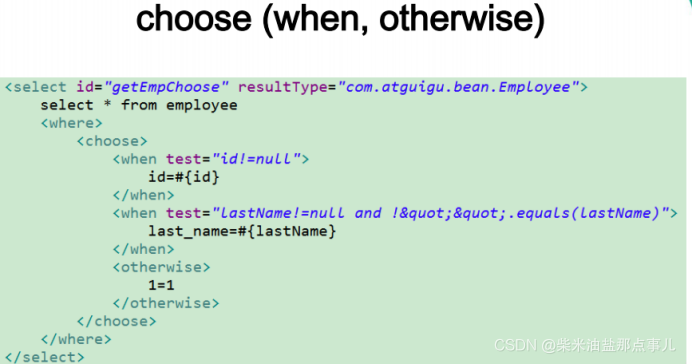
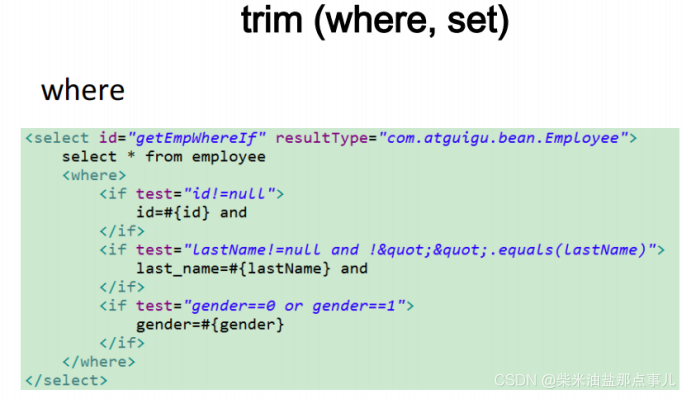
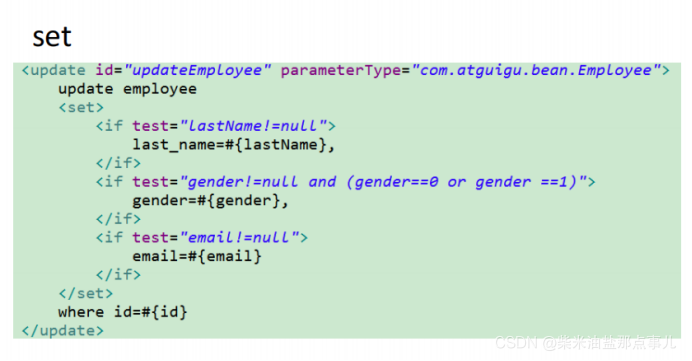
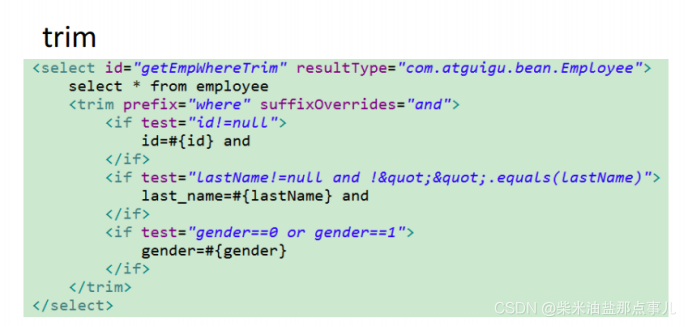
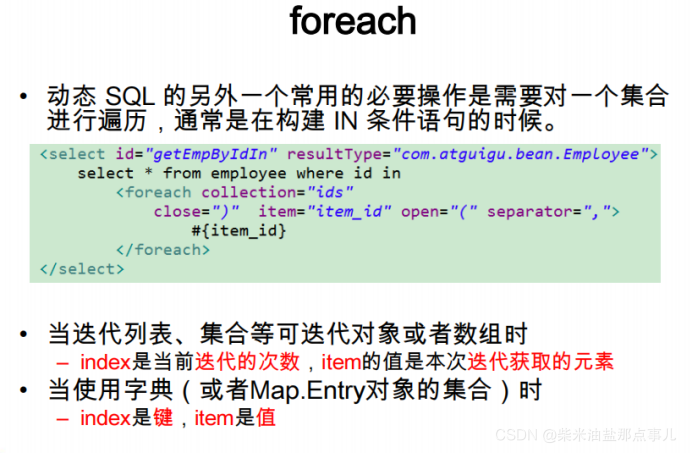
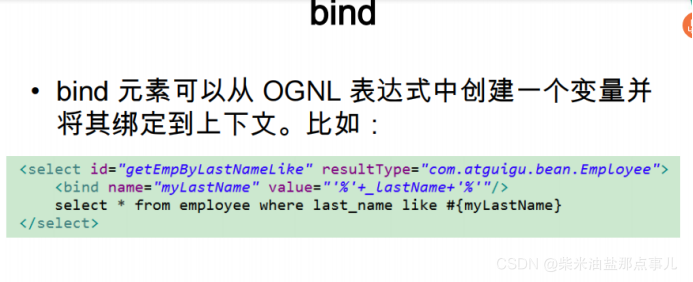
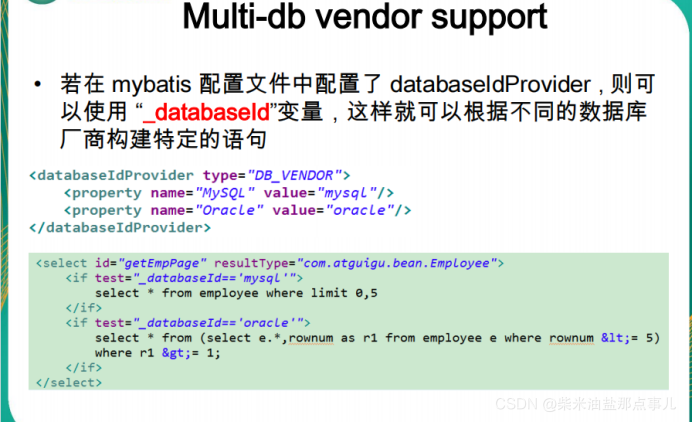
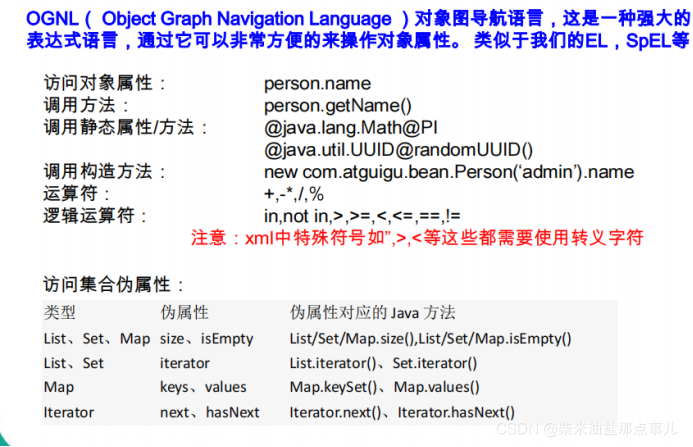
MyBatis-缓存机制
MyBatisTest.java
package com.atguigu.mybatis.test;
import java.io.IOException;
import java.io.InputStream;
import java.util.ArrayList;
import java.util.Arrays;
import java.util.HashMap;
import java.util.List;
import java.util.Map;
import org.apache.ibatis.io.Resources;
import org.apache.ibatis.session.SqlSession;
import org.apache.ibatis.session.SqlSessionFactory;
import org.apache.ibatis.session.SqlSessionFactoryBuilder;
import org.junit.Test;
import com.atguigu.mybatis.bean.Department;
import com.atguigu.mybatis.bean.Employee;
import com.atguigu.mybatis.dao.DepartmentMapper;
import com.atguigu.mybatis.dao.EmployeeMapper;
import com.atguigu.mybatis.dao.EmployeeMapperAnnotation;
import com.atguigu.mybatis.dao.EmployeeMapperDynamicSQL;
import com.atguigu.mybatis.dao.EmployeeMapperPlus;
public class MyBatisTest {
public SqlSessionFactory getSqlSessionFactory() throws IOException {
String resource = "mybatis-config.xml";
InputStream inputStream = Resources.getResourceAsStream(resource);
return new SqlSessionFactoryBuilder().build(inputStream);
}
/**
* 两级缓存:
* 一级缓存:(本地缓存):sqlSession级别的缓存。一级缓存是一直开启的;SqlSession级别的一个Map
* 与数据库同一次会话期间查询到的数据会放在本地缓存中。
* 以后如果需要获取相同的数据,直接从缓存中拿,没必要再去查询数据库;
*
* 一级缓存失效情况(没有使用到当前一级缓存的情况,效果就是,还需要再向数据库发出查询):
* 1、sqlSession不同。
* 2、sqlSession相同,查询条件不同.(当前一级缓存中还没有这个数据)
* 3、sqlSession相同,两次查询之间执行了增删改操作(这次增删改可能对当前数据有影响)
* 4、sqlSession相同,手动清除了一级缓存(缓存清空)
*
* 二级缓存:(全局缓存):基于namespace级别的缓存:一个namespace对应一个二级缓存:
* 工作机制:
* 1、一个会话,查询一条数据,这个数据就会被放在当前会话的一级缓存中;
* 2、如果会话关闭;一级缓存中的数据会被保存到二级缓存中;新的会话查询信息,就可以参照二级缓存中的内容;
* 3、sqlSession===EmployeeMapper==>Employee
* DepartmentMapper===>Department
* 不同namespace查出的数据会放在自己对应的缓存中(map)
* 效果:数据会从二级缓存中获取
* 查出的数据都会被默认先放在一级缓存中。
* 只有会话提交或者关闭以后,一级缓存中的数据才会转移到二级缓存中
* 使用:
* 1)、开启全局二级缓存配置:<setting name="cacheEnabled" value="true"/>
* 2)、去mapper.xml中配置使用二级缓存:
* <cache></cache>
* 3)、我们的POJO需要实现序列化接口
*
* 和缓存有关的设置/属性:
* 1)、cacheEnabled=true:false:关闭缓存(二级缓存关闭)(一级缓存一直可用的)
* 2)、每个select标签都有useCache="true":
* false:不使用缓存(一级缓存依然使用,二级缓存不使用)
* 3)、【每个增删改标签的:flushCache="true":(一级二级都会清除)】
* 增删改执行完成后就会清楚缓存;
* 测试:flushCache="true":一级缓存就清空了;二级也会被清除;
* 查询标签:flushCache="false":
* 如果flushCache=true;每次查询之后都会清空缓存;缓存是没有被使用的;
* 4)、sqlSession.clearCache();只是清楚当前session的一级缓存;
* 5)、localCacheScope:本地缓存作用域:(一级缓存SESSION);当前会话的所有数据保存在会话缓存中;
* STATEMENT:可以禁用一级缓存;
*
*第三方缓存整合:
* 1)、导入第三方缓存包即可;
* 2)、导入与第三方缓存整合的适配包;官方有;
* 3)、mapper.xml中使用自定义缓存
* <cache type="org.mybatis.caches.ehcache.EhcacheCache"></cache>
*
* @throws IOException
*
*/
@Test
public void testSecondLevelCache02() throws IOException{
SqlSessionFactory sqlSessionFactory = getSqlSessionFactory();
SqlSession openSession = sqlSessionFactory.openSession();
SqlSession openSession2 = sqlSessionFactory.openSession();
try{
//1、
DepartmentMapper mapper = openSession.getMapper(DepartmentMapper.class);
DepartmentMapper mapper2 = openSession2.getMapper(DepartmentMapper.class);
Department deptById = mapper.getDeptById(1);
System.out.println(deptById);
openSession.close();
Department deptById2 = mapper2.getDeptById(1);
System.out.println(deptById2);
openSession2.close();
//第二次查询是从二级缓存中拿到的数据,并没有发送新的sql
}finally{
}
}
@Test
public void testSecondLevelCache() throws IOException{
SqlSessionFactory sqlSessionFactory = getSqlSessionFactory();
SqlSession openSession = sqlSessionFactory.openSession();
SqlSession openSession2 = sqlSessionFactory.openSession();
try{
//1、
EmployeeMapper mapper = openSession.getMapper(EmployeeMapper.class);
EmployeeMapper mapper2 = openSession2.getMapper(EmployeeMapper.class);
Employee emp01 = mapper.getEmpById(1);
System.out.println(emp01);
openSession.close();
//第二次查询是从二级缓存中拿到的数据,并没有发送新的sql
//mapper2.addEmp(new Employee(null, "aaa", "nnn", "0"));
Employee emp02 = mapper2.getEmpById(1);
System.out.println(emp02);
openSession2.close();
}finally{
}
}
@Test
public void testFirstLevelCache() throws IOException{
SqlSessionFactory sqlSessionFactory = getSqlSessionFactory();
SqlSession openSession = sqlSessionFactory.openSession();
try{
EmployeeMapper mapper = openSession.getMapper(EmployeeMapper.class);
Employee emp01 = mapper.getEmpById(1);
System.out.println(emp01);
//xxxxx
//1、sqlSession不同。
//SqlSession openSession2 = sqlSessionFactory.openSession();
//EmployeeMapper mapper2 = openSession2.getMapper(EmployeeMapper.class);
//2、sqlSession相同,查询条件不同
//3、sqlSession相同,两次查询之间执行了增删改操作(这次增删改可能对当前数据有影响)
//mapper.addEmp(new Employee(null, "testCache", "cache", "1"));
//System.out.println("数据添加成功");
//4、sqlSession相同,手动清除了一级缓存(缓存清空)
//openSession.clearCache();
Employee emp02 = mapper.getEmpById(1);
//Employee emp03 = mapper.getEmpById(3);
System.out.println(emp02);
//System.out.println(emp03);
System.out.println(emp01==emp02);
//openSession2.close();
}finally{
openSession.close();
}
}
}
EmployeeMapper.xml
<?xml version="1.0" encoding="UTF-8" ?>
<!DOCTYPE mapper
PUBLIC "-//mybatis.org//DTD Mapper 3.0//EN"
"http://mybatis.org/dtd/mybatis-3-mapper.dtd">
<mapper namespace="com.atguigu.mybatis.dao.EmployeeMapper">
<cache type="org.mybatis.caches.ehcache.EhcacheCache"></cache>
<!-- <cache eviction="FIFO" flushInterval="60000" readOnly="false" size="1024"></cache> -->
<!--
eviction:缓存的回收策略:
• LRU – 最近最少使用的:移除最长时间不被使用的对象。
• FIFO – 先进先出:按对象进入缓存的顺序来移除它们。
• SOFT – 软引用:移除基于垃圾回收器状态和软引用规则的对象。
• WEAK – 弱引用:更积极地移除基于垃圾收集器状态和弱引用规则的对象。
• 默认的是 LRU。
flushInterval:缓存刷新间隔
缓存多长时间清空一次,默认不清空,设置一个毫秒值
readOnly:是否只读:
true:只读;mybatis认为所有从缓存中获取数据的操作都是只读操作,不会修改数据。
mybatis为了加快获取速度,直接就会将数据在缓存中的引用交给用户。不安全,速度快
false:非只读:mybatis觉得获取的数据可能会被修改。
mybatis会利用序列化&反序列的技术克隆一份新的数据给你。安全,速度慢
size:缓存存放多少元素;
type="":指定自定义缓存的全类名;
实现Cache接口即可;
-->
<!--
namespace:名称空间;指定为接口的全类名
id:唯一标识
resultType:返回值类型
#{id}:从传递过来的参数中取出id值
public Employee getEmpById(Integer id);
-->
<!--public Map<Integer, Employee> getEmpByLastNameLikeReturnMap(String lastName); -->
<select id="getEmpByLastNameLikeReturnMap" resultType="com.atguigu.mybatis.bean.Employee">
select * from tbl_employee where last_name like #{lastName}
</select>
<!--public Map<String, Object> getEmpByIdReturnMap(Integer id); -->
<select id="getEmpByIdReturnMap" resultType="map">
select * from tbl_employee where id=#{id}
</select>
<!-- public List<Employee> getEmpsByLastNameLike(String lastName); -->
<!--resultType:如果返回的是一个集合,要写集合中元素的类型 -->
<select id="getEmpsByLastNameLike" resultType="com.atguigu.mybatis.bean.Employee">
select * from tbl_employee where last_name like #{lastName}
</select>
<!-- public Employee getEmpByMap(Map<String, Object> map); -->
<select id="getEmpByMap" resultType="com.atguigu.mybatis.bean.Employee">
select * from ${tableName} where id=${id} and last_name=#{lastName}
</select>
<!-- public Employee getEmpByIdAndLastName(Integer id,String lastName);-->
<select id="getEmpByIdAndLastName" resultType="com.atguigu.mybatis.bean.Employee">
select * from tbl_employee where id = #{id} and last_name=#{lastName}
</select>
<select id="getEmpById" resultType="com.atguigu.mybatis.bean.Employee">
select * from tbl_employee where id = #{id}
</select>
<select id="getEmpById" resultType="com.atguigu.mybatis.bean.Employee"
databaseId="mysql" useCache="true">
select * from tbl_employee where id = #{id}
</select>
<select id="getEmpById" resultType="com.atguigu.mybatis.bean.Employee"
databaseId="oracle">
select EMPLOYEE_ID id,LAST_NAME lastName,EMAIL email
from employees where EMPLOYEE_ID=#{id}
</select>
<!-- public void addEmp(Employee employee); -->
<!-- parameterType:参数类型,可以省略,
获取自增主键的值:
mysql支持自增主键,自增主键值的获取,mybatis也是利用statement.getGenreatedKeys();
useGeneratedKeys="true";使用自增主键获取主键值策略
keyProperty;指定对应的主键属性,也就是mybatis获取到主键值以后,将这个值封装给javaBean的哪个属性
-->
<insert id="addEmp" parameterType="com.atguigu.mybatis.bean.Employee"
useGeneratedKeys="true" keyProperty="id" databaseId="mysql"
flushCache="true">
insert into tbl_employee(last_name,email,gender)
values(#{lastName},#{email},#{gender})
</insert>
<!--
获取非自增主键的值:
Oracle不支持自增;Oracle使用序列来模拟自增;
每次插入的数据的主键是从序列中拿到的值;如何获取到这个值;
-->
<insert id="addEmp" databaseId="oracle">
<!--
keyProperty:查出的主键值封装给javaBean的哪个属性
order="BEFORE":当前sql在插入sql之前运行
AFTER:当前sql在插入sql之后运行
resultType:查出的数据的返回值类型
BEFORE运行顺序:
先运行selectKey查询id的sql;查出id值封装给javaBean的id属性
在运行插入的sql;就可以取出id属性对应的值
AFTER运行顺序:
先运行插入的sql(从序列中取出新值作为id);
再运行selectKey查询id的sql;
-->
<selectKey keyProperty="id" order="BEFORE" resultType="Integer">
<!-- 编写查询主键的sql语句 -->
<!-- BEFORE-->
select EMPLOYEES_SEQ.nextval from dual
<!-- AFTER:
select EMPLOYEES_SEQ.currval from dual -->
</selectKey>
<!-- 插入时的主键是从序列中拿到的 -->
<!-- BEFORE:-->
insert into employees(EMPLOYEE_ID,LAST_NAME,EMAIL)
values(#{id},#{lastName},#{email<!-- ,jdbcType=NULL -->})
<!-- AFTER:
insert into employees(EMPLOYEE_ID,LAST_NAME,EMAIL)
values(employees_seq.nextval,#{lastName},#{email}) -->
</insert>
<!-- public void updateEmp(Employee employee); -->
<update id="updateEmp">
update tbl_employee
set last_name=#{lastName},email=#{email},gender=#{gender}
where id=#{id}
</update>
<!-- public void deleteEmpById(Integer id); -->
<delete id="deleteEmpById">
delete from tbl_employee where id=#{id}
</delete>
</mapper>
mybatis-config.xml
<?xml version="1.0" encoding="UTF-8" ?>
<!DOCTYPE configuration
PUBLIC "-//mybatis.org//DTD Config 3.0//EN"
"http://mybatis.org/dtd/mybatis-3-config.dtd">
<configuration>
<!--
1、mybatis可以使用properties来引入外部properties配置文件的内容;
resource:引入类路径下的资源
url:引入网络路径或者磁盘路径下的资源
-->
<properties resource="dbconfig.properties"></properties>
<!--
2、settings包含很多重要的设置项
setting:用来设置每一个设置项
name:设置项名
value:设置项取值
-->
<settings>
<setting name="mapUnderscoreToCamelCase" value="true"/>
<setting name="jdbcTypeForNull" value="NULL"/>
<!--显式的指定每个我们需要更改的配置的值,即使他是默认的。防止版本更新带来的问题 -->
<setting name="cacheEnabled" value="true"/>
<setting name="lazyLoadingEnabled" value="true"/>
<setting name="aggressiveLazyLoading" value="false"/>
</settings>
<!-- 3、typeAliases:别名处理器:可以为我们的java类型起别名
别名不区分大小写
-->
<typeAliases>
<!-- 1、typeAlias:为某个java类型起别名
type:指定要起别名的类型全类名;默认别名就是类名小写;employee
alias:指定新的别名
-->
<!-- <typeAlias type="com.atguigu.mybatis.bean.Employee" alias="emp"/> -->
<!-- 2、package:为某个包下的所有类批量起别名
name:指定包名(为当前包以及下面所有的后代包的每一个类都起一个默认别名(类名小写),)
-->
<package name="com.atguigu.mybatis.bean"/>
<!-- 3、批量起别名的情况下,使用@Alias注解为某个类型指定新的别名 -->
</typeAliases>
<!--
4、environments:环境们,mybatis可以配置多种环境 ,default指定使用某种环境。可以达到快速切换环境。
environment:配置一个具体的环境信息;必须有两个标签;id代表当前环境的唯一标识
transactionManager:事务管理器;
type:事务管理器的类型;JDBC(JdbcTransactionFactory)|MANAGED(ManagedTransactionFactory)
自定义事务管理器:实现TransactionFactory接口.type指定为全类名
dataSource:数据源;
type:数据源类型;UNPOOLED(UnpooledDataSourceFactory)
|POOLED(PooledDataSourceFactory)
|JNDI(JndiDataSourceFactory)
自定义数据源:实现DataSourceFactory接口,type是全类名
-->
<environments default="dev_mysql">
<environment id="dev_mysql">
<transactionManager type="JDBC"></transactionManager>
<dataSource type="POOLED">
<property name="driver" value="${jdbc.driver}" />
<property name="url" value="${jdbc.url}" />
<property name="username" value="${jdbc.username}" />
<property name="password" value="${jdbc.password}" />
</dataSource>
</environment>
<environment id="dev_oracle">
<transactionManager type="JDBC" />
<dataSource type="POOLED">
<property name="driver" value="${orcl.driver}" />
<property name="url" value="${orcl.url}" />
<property name="username" value="${orcl.username}" />
<property name="password" value="${orcl.password}" />
</dataSource>
</environment>
</environments>
<!-- 5、databaseIdProvider:支持多数据库厂商的;
type="DB_VENDOR":VendorDatabaseIdProvider
作用就是得到数据库厂商的标识(驱动getDatabaseProductName()),mybatis就能根据数据库厂商标识来执行不同的sql;
MySQL,Oracle,SQL Server,xxxx
-->
<databaseIdProvider type="DB_VENDOR">
<!-- 为不同的数据库厂商起别名 -->
<property name="MySQL" value="mysql"/>
<property name="Oracle" value="oracle"/>
<property name="SQL Server" value="sqlserver"/>
</databaseIdProvider>
<!-- 将我们写好的sql映射文件(EmployeeMapper.xml)一定要注册到全局配置文件(mybatis-config.xml)中 -->
<!-- 6、mappers:将sql映射注册到全局配置中 -->
<mappers>
<!--
mapper:注册一个sql映射
注册配置文件
resource:引用类路径下的sql映射文件
mybatis/mapper/EmployeeMapper.xml
url:引用网路路径或者磁盘路径下的sql映射文件
file:///var/mappers/AuthorMapper.xml
注册接口
class:引用(注册)接口,
1、有sql映射文件,映射文件名必须和接口同名,并且放在与接口同一目录下;
2、没有sql映射文件,所有的sql都是利用注解写在接口上;
推荐:
比较重要的,复杂的Dao接口我们来写sql映射文件
不重要,简单的Dao接口为了开发快速可以使用注解;
-->
<!-- <mapper resource="mybatis/mapper/EmployeeMapper.xml"/> -->
<!-- <mapper class="com.atguigu.mybatis.dao.EmployeeMapperAnnotation"/> -->
<!-- 批量注册: -->
<package name="com.atguigu.mybatis.dao"/>
</mappers>
</configuration>
理论
MyBatis 包含一个非常强大的查询缓存特性,它可以非
常方便地配置和定制。缓存可以极大的提升查询效率。
• MyBatis系统中默认定义了两级缓存。
• 一级缓存和二级缓存。
– 1、默认情况下,只有一级缓存(SqlSession级别的缓存,
也称为本地缓存)开启。
– 2、二级缓存需要手动开启和配置,他是基于namespace级
别的缓存。
– 3、为了提高扩展性。MyBatis定义了缓存接口Cache。我们
可以通过实现Cache接口来自定义二级缓存
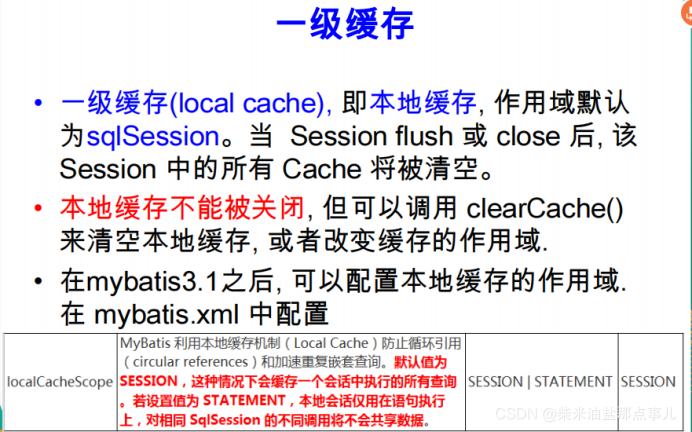
一级缓存演示&失效情况
• 同一次会话期间只要查询过的数据都会保存在当
前SqlSession的一个Map中
• key:hashCode+查询的SqlId+编写的sql查询语句+参数
• 一级缓存失效的四种情况
– 1、不同的SqlSession对应不同的一级缓存
– 2、同一个SqlSession但是查询条件不同
– 3、同一个SqlSession两次查询期间执行了任何一次增
删改操作
– 4、同一个SqlSession两次查询期间手动清空了缓存
二级缓存
• 二级缓存(second level cache),全局作用域缓存
• 二级缓存默认不开启,需要手动配置
• MyBatis提供二级缓存的接口以及实现,缓存实现要求
POJO实现Serializable接口
• 二级缓存在 SqlSession 关闭或提交之后才会生效
• 使用步骤
– 1、全局配置文件中开启二级缓存
• <setting name="cacheEnabled" value="true"/>
– 2、需要使用二级缓存的映射文件处使用cache配置缓存
• <cache />
– 3、注意:
缓存相关属性
• eviction=“FIFO”:缓存回收策略:
• LRU – 最近最少使用的:移除最长时间不被使用的对象。
• FIFO – 先进先出:按对象进入缓存的顺序来移除它们。
• SOFT – 软引用:移除基于垃圾回收器状态和软引用规则的对象。
• WEAK – 弱引用:更积极地移除基于垃圾收集器状态和弱引用规则的对象。
• 默认的是 LRU。
• flushInterval:刷新间隔,单位毫秒
• 默认情况是不设置,也就是没有刷新间隔,缓存仅仅调用语句时刷新
• size:引用数目,正整数
• 代表缓存最多可以存储多少个对象,太大容易导致内存溢出
• readOnly:只读,true/false
• true:只读缓存;会给所有调用者返回缓存对象的相同实例。因此这些对象
不能被修改。这提供了很重要的性能优势。
• false:读写缓存;会返回缓存对象的拷贝(通过序列化)。这会慢一些,
缓存有关设置
• 1、全局setting的cacheEnable:
– 配置二级缓存的开关。一级缓存一直是打开的。
• 2、select标签的useCache属性:
– 配置这个select是否使用二级缓存。一级缓存一直是使用的
• 3、sql标签的flushCache属性:
– 增删改默认flushCache=true。sql执行以后,会同时清空一级和二级缓存。
查询默认flushCache=false。
• 4、sqlSession.clearCache():
– 只是用来清除一级缓存。
• 5、当在某一个作用域 (一级缓存Session/二级缓存
Namespaces) 进行了 C/U/D 操作后,默认该作用域下所
有 select 中的缓存将被clear。

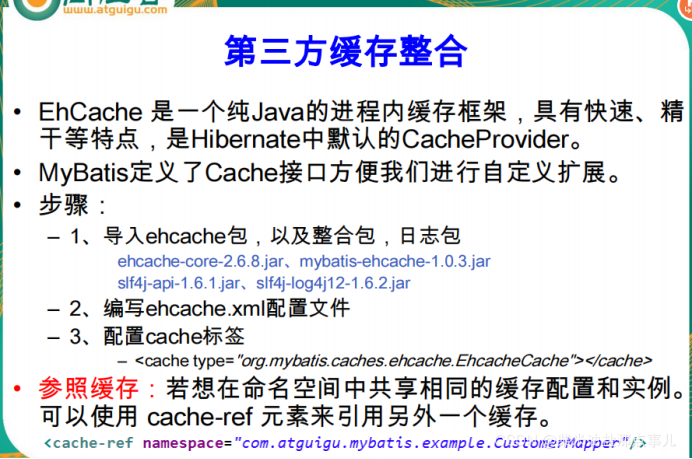
MyBatis-Spring整合
Spring + SpringMVC+mybits
注意 整合mybatis Spring配置 SpringMVC配置
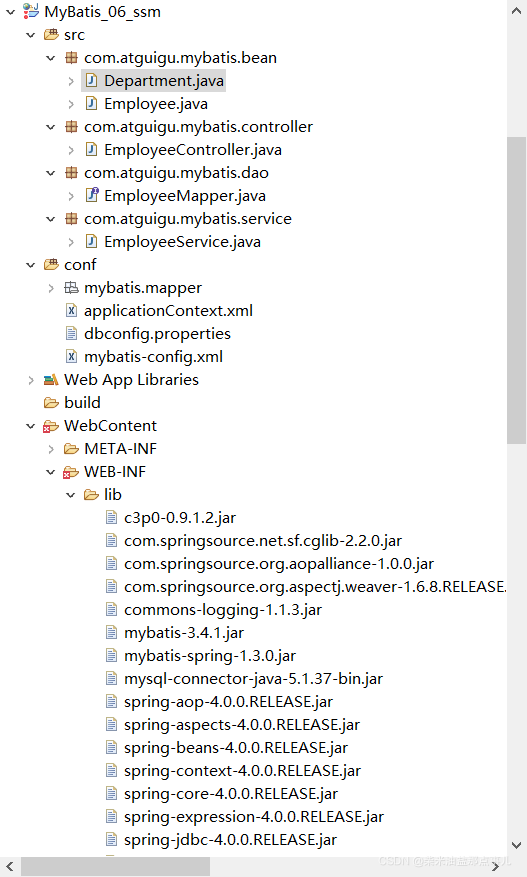

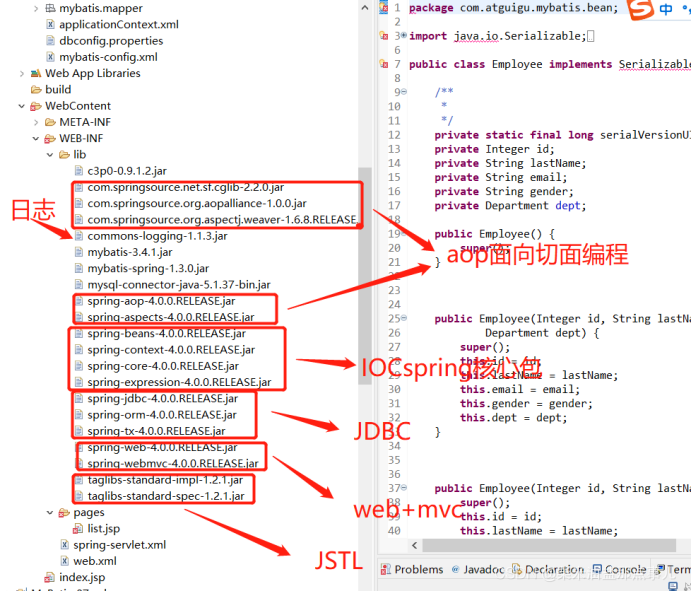
Department.java
package com.atguigu.mybatis.bean;
import java.io.Serializable;
import java.util.List;
public class Department implements Serializable{
/**
*
*/
private static final long serialVersionUID = 1L;
private Integer id;
private String departmentName;
private List<Employee> emps;
public Department(Integer id) {
super();
this.id = id;
}
public Department() {
super();
// TODO Auto-generated constructor stub
}
public List<Employee> getEmps() {
return emps;
}
public void setEmps(List<Employee> emps) {
this.emps = emps;
}
public Integer getId() {
return id;
}
public void setId(Integer id) {
this.id = id;
}
public String getDepartmentName() {
return departmentName;
}
public void setDepartmentName(String departmentName) {
this.departmentName = departmentName;
}
@Override
public String toString() {
return "Department [id=" + id + ", departmentName=" + departmentName
+ "]";
}
}
Employee.java
package com.atguigu.mybatis.bean;
import java.io.Serializable;
import org.apache.ibatis.type.Alias;
public class Employee implements Serializable{
/**
*
*/
private static final long serialVersionUID = 1L;
private Integer id;
private String lastName;
private String email;
private String gender;
private Department dept;
public Employee() {
super();
}
public Employee(Integer id, String lastName, String email, String gender,
Department dept) {
super();
this.id = id;
this.lastName = lastName;
this.email = email;
this.gender = gender;
this.dept = dept;
}
public Employee(Integer id, String lastName, String email, String gender) {
super();
this.id = id;
this.lastName = lastName;
this.email = email;
this.gender = gender;
}
public Department getDept() {
return dept;
}
public void setDept(Department dept) {
this.dept = dept;
}
public Integer getId() {
return id;
}
public void setId(Integer id) {
this.id = id;
}
public String getLastName() {
return lastName;
}
public void setLastName(String lastName) {
this.lastName = lastName;
}
public String getEmail() {
return email;
}
public void setEmail(String email) {
this.email = email;
}
public String getGender() {
return gender;
}
public void setGender(String gender) {
this.gender = gender;
}
@Override
public String toString() {
return "Employee [id=" + id + ", lastName=" + lastName + ", email="
+ email + ", gender=" + gender + "]";
}
}
EmployeeController.java
package com.atguigu.mybatis.controller;
import java.util.List;
import java.util.Map;
import org.springframework.beans.factory.annotation.Autowired;
import org.springframework.stereotype.Controller;
import org.springframework.web.bind.annotation.RequestMapping;
import com.atguigu.mybatis.bean.Employee;
import com.atguigu.mybatis.service.EmployeeService;
@Controller
public class EmployeeController {
@Autowired
EmployeeService employeeService;
@RequestMapping("/getemps")
public String emps(Map<String,Object> map){
List<Employee> emps = employeeService.getEmps();
map.put("allEmps", emps);
return "list";
}
}
EmployeeMapper.java
package com.atguigu.mybatis.dao;
import java.util.List;
import com.atguigu.mybatis.bean.Employee;
public interface EmployeeMapper {
public Employee getEmpById(Integer id);
public List<Employee> getEmps();
}
EmployeeService.java
package com.atguigu.mybatis.service;
import java.util.List;
import org.apache.ibatis.session.SqlSession;
import org.springframework.beans.factory.annotation.Autowired;
import org.springframework.stereotype.Service;
import com.atguigu.mybatis.bean.Employee;
import com.atguigu.mybatis.dao.EmployeeMapper;
@Service
public class EmployeeService {
@Autowired
private EmployeeMapper employeeMapper;
@Autowired
private SqlSession sqlSession;
public List<Employee> getEmps(){
//
//EmployeeMapper mapper = sqlSession.getMapper(EmployeeMapper.class);
return employeeMapper.getEmps();
}
}
EmployeeMapper.xml
<?xml version="1.0" encoding="UTF-8" ?>
<!DOCTYPE mapper
PUBLIC "-//mybatis.org//DTD Mapper 3.0//EN"
"http://mybatis.org/dtd/mybatis-3-mapper.dtd">
<mapper namespace="com.atguigu.mybatis.dao.EmployeeMapper">
<!-- public Employee getEmpById(Integer id); -->
<select id="getEmpById" resultType="com.atguigu.mybatis.bean.Employee">
select * from tbl_employee where id=#{id}
</select>
<!--public List<Employee> getEmps(); -->
<select id="getEmps" resultType="com.atguigu.mybatis.bean.Employee">
select * from tbl_employee
</select>
</mapper>
applicationContext.xml
<?xml version="1.0" encoding="UTF-8"?>
<beans xmlns="http://www.springframework.org/schema/beans"
xmlns:xsi="http://www.w3.org/2001/XMLSchema-instance"
xmlns:context="http://www.springframework.org/schema/context"
xmlns:mybatis-spring="http://mybatis.org/schema/mybatis-spring"
xmlns:tx="http://www.springframework.org/schema/tx"
xsi:schemaLocation="http://www.springframework.org/schema/beans http://www.springframework.org/schema/beans/spring-beans.xsd
http://mybatis.org/schema/mybatis-spring http://mybatis.org/schema/mybatis-spring-1.2.xsd
http://www.springframework.org/schema/tx http://www.springframework.org/schema/tx/spring-tx-4.0.xsd
http://www.springframework.org/schema/context http://www.springframework.org/schema/context/spring-context-4.0.xsd">
<!-- Spring希望管理所有的业务逻辑组件,等。。。 -->
<context:component-scan base-package="com.atguigu.mybatis">
<context:exclude-filter type="annotation"
expression="org.springframework.stereotype.Controller" />
</context:component-scan>
<!-- 引入数据库的配置文件 -->
<context:property-placeholder location="classpath:dbconfig.properties" />
<!-- Spring用来控制业务逻辑。数据源、事务控制、aop -->
<bean id="dataSource" class="com.mchange.v2.c3p0.ComboPooledDataSource">
<property name="jdbcUrl" value="${jdbc.url}"></property>
<property name="driverClass" value="${jdbc.driver}"></property>
<property name="user" value="${jdbc.username}"></property>
<property name="password" value="${jdbc.password}"></property>
</bean>
<!-- spring事务管理 -->
<bean id="dataSourceTransactionManager" class="org.springframework.jdbc.datasource.DataSourceTransactionManager">
<property name="dataSource" ref="dataSource"></property>
</bean>
<!-- 开启基于注解的事务 -->
<tx:annotation-driven transaction-manager="dataSourceTransactionManager"/>
<!--
整合mybatis
目的:1、spring管理所有组件。mapper的实现类。
service==>Dao @Autowired:自动注入mapper;
2、spring用来管理事务,spring声明式事务
-->
<!--创建出SqlSessionFactory对象 -->
<bean id="sqlSessionFactoryBean" class="org.mybatis.spring.SqlSessionFactoryBean">
<property name="dataSource" ref="dataSource"></property>
<!-- configLocation指定全局配置文件的位置 -->
<property name="configLocation" value="classpath:mybatis-config.xml"></property>
<!--mapperLocations: 指定mapper文件的位置-->
<property name="mapperLocations" value="classpath:mybatis/mapper/*.xml"></property>
</bean>
<!--配置一个可以进行批量执行的sqlSession -->
<bean id="sqlSession" class="org.mybatis.spring.SqlSessionTemplate">
<constructor-arg name="sqlSessionFactory" ref="sqlSessionFactoryBean"></constructor-arg>
<constructor-arg name="executorType" value="BATCH"></constructor-arg>
</bean>
<!-- 扫描所有的mapper接口的实现,让这些mapper能够自动注入;
base-package:指定mapper接口的包名
-->
<mybatis-spring:scan base-package="com.atguigu.mybatis.dao"/>
<!-- <bean class="org.mybatis.spring.mapper.MapperScannerConfigurer">
<property name="basePackage" value="com.atguigu.mybatis.dao"></property>
</bean> -->
</beans>
dbconfig.properties
jdbc.driver=com.mysql.jdbc.Driver
jdbc.url=jdbc:mysql://localhost:3306/mybatis?allowMultiQueries=true
jdbc.username=root
jdbc.password=123456
orcl.driver=oracle.jdbc.OracleDriver
orcl.url=jdbc:oracle:thin:@localhost:1521:orcl
orcl.username=scott
orcl.password=123456
mybatis-config.xml
<?xml version="1.0" encoding="UTF-8" ?>
<!DOCTYPE configuration
PUBLIC "-//mybatis.org//DTD Config 3.0//EN"
"http://mybatis.org/dtd/mybatis-3-config.dtd">
<configuration>
<settings>
<setting name="mapUnderscoreToCamelCase" value="true"/>
<setting name="jdbcTypeForNull" value="NULL"/>
<!--显式的指定每个我们需要更改的配置的值,即使他是默认的。防止版本更新带来的问题 -->
<setting name="cacheEnabled" value="true"/>
<setting name="lazyLoadingEnabled" value="true"/>
<setting name="aggressiveLazyLoading" value="false"/>
</settings>
<databaseIdProvider type="DB_VENDOR">
<property name="MySQL" value="mysql"/>
<property name="Oracle" value="oracle"/>
<property name="SQL Server" value="sqlserver"/>
</databaseIdProvider>
</configuration>
list.jsp
<%@ page language="java" contentType="text/html; charset=UTF-8"
pageEncoding="UTF-8"%>
<%@taglib prefix="c" uri="http://java.sun.com/jsp/jstl/core" %>
<!DOCTYPE html PUBLIC "-//W3C//DTD HTML 4.01 Transitional//EN" "http://www.w3.org/TR/html4/loose.dtd">
<html>
<head>
<meta http-equiv="Content-Type" content="text/html; charset=UTF-8">
<title>员工列表</title>
</head>
<body>
<table>
<tr>
<td>id</td>
<td>lastName</td>
<td>email</td>
<td>gender</td>
</tr>
<c:forEach items="${allEmps }" var="emp">
<tr>
<td>${emp.id }</td>
<td>${emp.lastName }</td>
<td>${emp.email }</td>
<td>${emp.gender }</td>
</tr>
</c:forEach>
</table>
</body>
</html>
spring-servlet.xml
<?xml version="1.0" encoding="UTF-8"?>
<beans xmlns="http://www.springframework.org/schema/beans"
xmlns:xsi="http://www.w3.org/2001/XMLSchema-instance"
xmlns:context="http://www.springframework.org/schema/context"
xmlns:mvc="http://www.springframework.org/schema/mvc"
xsi:schemaLocation="http://www.springframework.org/schema/mvc http://www.springframework.org/schema/mvc/spring-mvc-4.0.xsd
http://www.springframework.org/schema/beans http://www.springframework.org/schema/beans/spring-beans.xsd
http://www.springframework.org/schema/context http://www.springframework.org/schema/context/spring-context-4.0.xsd">
<!--SpringMVC只是控制网站跳转逻辑 -->
<!-- 只扫描控制器 -->
<context:component-scan base-package="com.atguigu.mybatis" use-default-filters="false">
<context:include-filter type="annotation" expression="org.springframework.stereotype.Controller"/>
</context:component-scan>
<!-- 视图解析器 -->
<bean class="org.springframework.web.servlet.view.InternalResourceViewResolver">
<property name="prefix" value="/WEB-INF/pages/"></property>
<property name="suffix" value=".jsp"></property>
</bean>
<mvc:annotation-driven></mvc:annotation-driven>
<mvc:default-servlet-handler/>
</beans>
web.xml
<?xml version="1.0" encoding="UTF-8"?>
<web-app xmlns:xsi="http://www.w3.org/2001/XMLSchema-instance" xmlns="http://java.sun.com/xml/ns/javaee" xsi:schemaLocation="http://java.sun.com/xml/ns/javaee http://java.sun.com/xml/ns/javaee/web-app_2_5.xsd" id="WebApp_ID" version="2.5">
<display-name>MyBatis_06_ssm</display-name>
<!--Spring配置: needed for ContextLoaderListener -->
<context-param>
<param-name>contextConfigLocation</param-name>
<param-value>classpath:applicationContext.xml</param-value>
</context-param>
<!-- Bootstraps the root web application context before servlet initialization -->
<listener>
<listener-class>org.springframework.web.context.ContextLoaderListener</listener-class>
</listener>
<!-- SpringMVC配置 -->
<!-- The front controller of this Spring Web application, responsible for handling all application requests -->
<servlet>
<servlet-name>spring</servlet-name>
<servlet-class>org.springframework.web.servlet.DispatcherServlet</servlet-class>
<load-on-startup>1</load-on-startup>
</servlet>
<!-- Map all requests to the DispatcherServlet for handling -->
<servlet-mapping>
<servlet-name>spring</servlet-name>
<url-pattern>/</url-pattern>
</servlet-mapping>
</web-app>
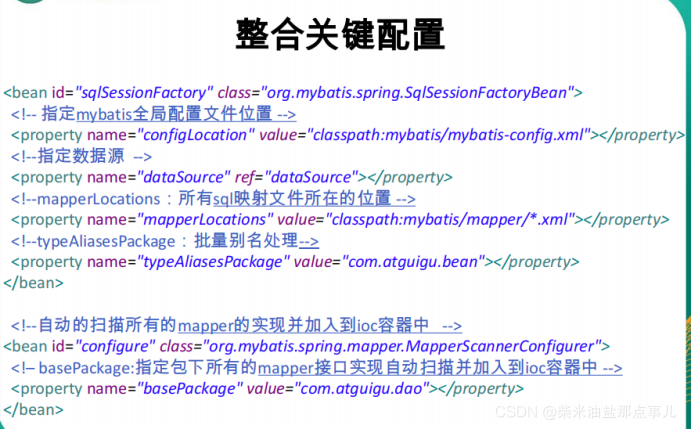
MyBatis-逆向工程
目录
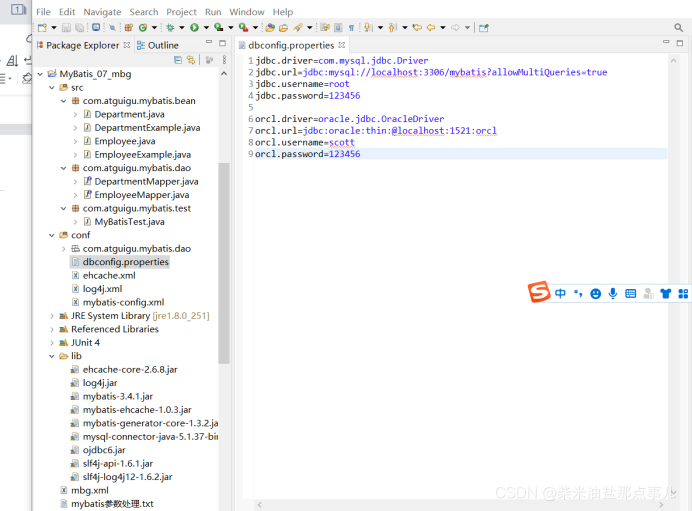
Department.java
package com.atguigu.mybatis.bean;
public class Department {
/**
* This field was generated by MyBatis Generator.
* This field corresponds to the database column tbl_dept.id
*
* @mbggenerated Sat Mar 25 13:59:48 GMT+08:00 2017
*/
private Integer id;
/**
* This field was generated by MyBatis Generator.
* This field corresponds to the database column tbl_dept.dept_name
*
* @mbggenerated Sat Mar 25 13:59:48 GMT+08:00 2017
*/
private String deptName;
/**
* This method was generated by MyBatis Generator.
* This method returns the value of the database column tbl_dept.id
*
* @return the value of tbl_dept.id
*
* @mbggenerated Sat Mar 25 13:59:48 GMT+08:00 2017
*/
public Integer getId() {
return id;
}
/**
* This method was generated by MyBatis Generator.
* This method sets the value of the database column tbl_dept.id
*
* @param id the value for tbl_dept.id
*
* @mbggenerated Sat Mar 25 13:59:48 GMT+08:00 2017
*/
public void setId(Integer id) {
this.id = id;
}
/**
* This method was generated by MyBatis Generator.
* This method returns the value of the database column tbl_dept.dept_name
*
* @return the value of tbl_dept.dept_name
*
* @mbggenerated Sat Mar 25 13:59:48 GMT+08:00 2017
*/
public String getDeptName() {
return deptName;
}
/**
* This method was generated by MyBatis Generator.
* This method sets the value of the database column tbl_dept.dept_name
*
* @param deptName the value for tbl_dept.dept_name
*
* @mbggenerated Sat Mar 25 13:59:48 GMT+08:00 2017
*/
public void setDeptName(String deptName) {
this.deptName = deptName == null ? null : deptName.trim();
}
}
DepartmentExample.java
package com.atguigu.mybatis.bean;
import java.util.ArrayList;
import java.util.List;
public class DepartmentExample {
/**
* This field was generated by MyBatis Generator.
* This field corresponds to the database table tbl_dept
*
* @mbggenerated Sat Mar 25 13:59:48 GMT+08:00 2017
*/
protected String orderByClause;
/**
* This field was generated by MyBatis Generator.
* This field corresponds to the database table tbl_dept
*
* @mbggenerated Sat Mar 25 13:59:48 GMT+08:00 2017
*/
protected boolean distinct;
/**
* This field was generated by MyBatis Generator.
* This field corresponds to the database table tbl_dept
*
* @mbggenerated Sat Mar 25 13:59:48 GMT+08:00 2017
*/
protected List<Criteria> oredCriteria;
/**
* This method was generated by MyBatis Generator.
* This method corresponds to the database table tbl_dept
*
* @mbggenerated Sat Mar 25 13:59:48 GMT+08:00 2017
*/
public DepartmentExample() {
oredCriteria = new ArrayList<Criteria>();
}
/**
* This method was generated by MyBatis Generator.
* This method corresponds to the database table tbl_dept
*
* @mbggenerated Sat Mar 25 13:59:48 GMT+08:00 2017
*/
public void setOrderByClause(String orderByClause) {
this.orderByClause = orderByClause;
}
/**
* This method was generated by MyBatis Generator.
* This method corresponds to the database table tbl_dept
*
* @mbggenerated Sat Mar 25 13:59:48 GMT+08:00 2017
*/
public String getOrderByClause() {
return orderByClause;
}
/**
* This method was generated by MyBatis Generator.
* This method corresponds to the database table tbl_dept
*
* @mbggenerated Sat Mar 25 13:59:48 GMT+08:00 2017
*/
public void setDistinct(boolean distinct) {
this.distinct = distinct;
}
/**
* This method was generated by MyBatis Generator.
* This method corresponds to the database table tbl_dept
*
* @mbggenerated Sat Mar 25 13:59:48 GMT+08:00 2017
*/
public boolean isDistinct() {
return distinct;
}
/**
* This method was generated by MyBatis Generator.
* This method corresponds to the database table tbl_dept
*
* @mbggenerated Sat Mar 25 13:59:48 GMT+08:00 2017
*/
public List<Criteria> getOredCriteria() {
return oredCriteria;
}
/**
* This method was generated by MyBatis Generator.
* This method corresponds to the database table tbl_dept
*
* @mbggenerated Sat Mar 25 13:59:48 GMT+08:00 2017
*/
public void or(Criteria criteria) {
oredCriteria.add(criteria);
}
/**
* This method was generated by MyBatis Generator.
* This method corresponds to the database table tbl_dept
*
* @mbggenerated Sat Mar 25 13:59:48 GMT+08:00 2017
*/
public Criteria or() {
Criteria criteria = createCriteriaInternal();
oredCriteria.add(criteria);
return criteria;
}
/**
* This method was generated by MyBatis Generator.
* This method corresponds to the database table tbl_dept
*
* @mbggenerated Sat Mar 25 13:59:48 GMT+08:00 2017
*/
public Criteria createCriteria() {
Criteria criteria = createCriteriaInternal();
if (oredCriteria.size() == 0) {
oredCriteria.add(criteria);
}
return criteria;
}
/**
* This method was generated by MyBatis Generator.
* This method corresponds to the database table tbl_dept
*
* @mbggenerated Sat Mar 25 13:59:48 GMT+08:00 2017
*/
protected Criteria createCriteriaInternal() {
Criteria criteria = new Criteria();
return criteria;
}
/**
* This method was generated by MyBatis Generator.
* This method corresponds to the database table tbl_dept
*
* @mbggenerated Sat Mar 25 13:59:48 GMT+08:00 2017
*/
public void clear() {
oredCriteria.clear();
orderByClause = null;
distinct = false;
}
/**
* This class was generated by MyBatis Generator.
* This class corresponds to the database table tbl_dept
*
* @mbggenerated Sat Mar 25 13:59:48 GMT+08:00 2017
*/
protected abstract static class GeneratedCriteria {
protected List<Criterion> criteria;
protected GeneratedCriteria() {
super();
criteria = new ArrayList<Criterion>();
}
public boolean isValid() {
return criteria.size() > 0;
}
public List<Criterion> getAllCriteria() {
return criteria;
}
public List<Criterion> getCriteria() {
return criteria;
}
protected void addCriterion(String condition) {
if (condition == null) {
throw new RuntimeException("Value for condition cannot be null");
}
criteria.add(new Criterion(condition));
}
protected void addCriterion(String condition, Object value, String property) {
if (value == null) {
throw new RuntimeException("Value for " + property + " cannot be null");
}
criteria.add(new Criterion(condition, value));
}
protected void addCriterion(String condition, Object value1, Object value2, String property) {
if (value1 == null || value2 == null) {
throw new RuntimeException("Between values for " + property + " cannot be null");
}
criteria.add(new Criterion(condition, value1, value2));
}
public Criteria andIdIsNull() {
addCriterion("id is null");
return (Criteria) this;
}
public Criteria andIdIsNotNull() {
addCriterion("id is not null");
return (Criteria) this;
}
public Criteria andIdEqualTo(Integer value) {
addCriterion("id =", value, "id");
return (Criteria) this;
}
public Criteria andIdNotEqualTo(Integer value) {
addCriterion("id <>", value, "id");
return (Criteria) this;
}
public Criteria andIdGreaterThan(Integer value) {
addCriterion("id >", value, "id");
return (Criteria) this;
}
public Criteria andIdGreaterThanOrEqualTo(Integer value) {
addCriterion("id >=", value, "id");
return (Criteria) this;
}
public Criteria andIdLessThan(Integer value) {
addCriterion("id <", value, "id");
return (Criteria) this;
}
public Criteria andIdLessThanOrEqualTo(Integer value) {
addCriterion("id <=", value, "id");
return (Criteria) this;
}
public Criteria andIdIn(List<Integer> values) {
addCriterion("id in", values, "id");
return (Criteria) this;
}
public Criteria andIdNotIn(List<Integer> values) {
addCriterion("id not in", values, "id");
return (Criteria) this;
}
public Criteria andIdBetween(Integer value1, Integer value2) {
addCriterion("id between", value1, value2, "id");
return (Criteria) this;
}
public Criteria andIdNotBetween(Integer value1, Integer value2) {
addCriterion("id not between", value1, value2, "id");
return (Criteria) this;
}
public Criteria andDeptNameIsNull() {
addCriterion("dept_name is null");
return (Criteria) this;
}
public Criteria andDeptNameIsNotNull() {
addCriterion("dept_name is not null");
return (Criteria) this;
}
public Criteria andDeptNameEqualTo(String value) {
addCriterion("dept_name =", value, "deptName");
return (Criteria) this;
}
public Criteria andDeptNameNotEqualTo(String value) {
addCriterion("dept_name <>", value, "deptName");
return (Criteria) this;
}
public Criteria andDeptNameGreaterThan(String value) {
addCriterion("dept_name >", value, "deptName");
return (Criteria) this;
}
public Criteria andDeptNameGreaterThanOrEqualTo(String value) {
addCriterion("dept_name >=", value, "deptName");
return (Criteria) this;
}
public Criteria andDeptNameLessThan(String value) {
addCriterion("dept_name <", value, "deptName");
return (Criteria) this;
}
public Criteria andDeptNameLessThanOrEqualTo(String value) {
addCriterion("dept_name <=", value, "deptName");
return (Criteria) this;
}
public Criteria andDeptNameLike(String value) {
addCriterion("dept_name like", value, "deptName");
return (Criteria) this;
}
public Criteria andDeptNameNotLike(String value) {
addCriterion("dept_name not like", value, "deptName");
return (Criteria) this;
}
public Criteria andDeptNameIn(List<String> values) {
addCriterion("dept_name in", values, "deptName");
return (Criteria) this;
}
public Criteria andDeptNameNotIn(List<String> values) {
addCriterion("dept_name not in", values, "deptName");
return (Criteria) this;
}
public Criteria andDeptNameBetween(String value1, String value2) {
addCriterion("dept_name between", value1, value2, "deptName");
return (Criteria) this;
}
public Criteria andDeptNameNotBetween(String value1, String value2) {
addCriterion("dept_name not between", value1, value2, "deptName");
return (Criteria) this;
}
}
/**
* This class was generated by MyBatis Generator.
* This class corresponds to the database table tbl_dept
*
* @mbggenerated do_not_delete_during_merge Sat Mar 25 13:59:48 GMT+08:00 2017
*/
public static class Criteria extends GeneratedCriteria {
protected Criteria() {
super();
}
}
/**
* This class was generated by MyBatis Generator.
* This class corresponds to the database table tbl_dept
*
* @mbggenerated Sat Mar 25 13:59:48 GMT+08:00 2017
*/
public static class Criterion {
private String condition;
private Object value;
private Object secondValue;
private boolean noValue;
private boolean singleValue;
private boolean betweenValue;
private boolean listValue;
private String typeHandler;
public String getCondition() {
return condition;
}
public Object getValue() {
return value;
}
public Object getSecondValue() {
return secondValue;
}
public boolean isNoValue() {
return noValue;
}
public boolean isSingleValue() {
return singleValue;
}
public boolean isBetweenValue() {
return betweenValue;
}
public boolean isListValue() {
return listValue;
}
public String getTypeHandler() {
return typeHandler;
}
protected Criterion(String condition) {
super();
this.condition = condition;
this.typeHandler = null;
this.noValue = true;
}
protected Criterion(String condition, Object value, String typeHandler) {
super();
this.condition = condition;
this.value = value;
this.typeHandler = typeHandler;
if (value instanceof List<?>) {
this.listValue = true;
} else {
this.singleValue = true;
}
}
protected Criterion(String condition, Object value) {
this(condition, value, null);
}
protected Criterion(String condition, Object value, Object secondValue, String typeHandler) {
super();
this.condition = condition;
this.value = value;
this.secondValue = secondValue;
this.typeHandler = typeHandler;
this.betweenValue = true;
}
protected Criterion(String condition, Object value, Object secondValue) {
this(condition, value, secondValue, null);
}
}
}
Employee.java
package com.atguigu.mybatis.bean;
public class Employee {
/**
* This field was generated by MyBatis Generator.
* This field corresponds to the database column tbl_employee.id
*
* @mbggenerated Sat Mar 25 13:59:48 GMT+08:00 2017
*/
private Integer id;
/**
* This field was generated by MyBatis Generator.
* This field corresponds to the database column tbl_employee.last_name
*
* @mbggenerated Sat Mar 25 13:59:48 GMT+08:00 2017
*/
private String lastName;
/**
* This field was generated by MyBatis Generator.
* This field corresponds to the database column tbl_employee.email
*
* @mbggenerated Sat Mar 25 13:59:48 GMT+08:00 2017
*/
private String email;
/**
* This field was generated by MyBatis Generator.
* This field corresponds to the database column tbl_employee.gender
*
* @mbggenerated Sat Mar 25 13:59:48 GMT+08:00 2017
*/
private String gender;
/**
* This field was generated by MyBatis Generator.
* This field corresponds to the database column tbl_employee.d_id
*
* @mbggenerated Sat Mar 25 13:59:48 GMT+08:00 2017
*/
private Integer dId;
/**
* This method was generated by MyBatis Generator.
* This method returns the value of the database column tbl_employee.id
*
* @return the value of tbl_employee.id
*
* @mbggenerated Sat Mar 25 13:59:48 GMT+08:00 2017
*/
public Integer getId() {
return id;
}
/**
* This method was generated by MyBatis Generator.
* This method sets the value of the database column tbl_employee.id
*
* @param id the value for tbl_employee.id
*
* @mbggenerated Sat Mar 25 13:59:48 GMT+08:00 2017
*/
public void setId(Integer id) {
this.id = id;
}
/**
* This method was generated by MyBatis Generator.
* This method returns the value of the database column tbl_employee.last_name
*
* @return the value of tbl_employee.last_name
*
* @mbggenerated Sat Mar 25 13:59:48 GMT+08:00 2017
*/
public String getLastName() {
return lastName;
}
/**
* This method was generated by MyBatis Generator.
* This method sets the value of the database column tbl_employee.last_name
*
* @param lastName the value for tbl_employee.last_name
*
* @mbggenerated Sat Mar 25 13:59:48 GMT+08:00 2017
*/
public void setLastName(String lastName) {
this.lastName = lastName == null ? null : lastName.trim();
}
/**
* This method was generated by MyBatis Generator.
* This method returns the value of the database column tbl_employee.email
*
* @return the value of tbl_employee.email
*
* @mbggenerated Sat Mar 25 13:59:48 GMT+08:00 2017
*/
public String getEmail() {
return email;
}
/**
* This method was generated by MyBatis Generator.
* This method sets the value of the database column tbl_employee.email
*
* @param email the value for tbl_employee.email
*
* @mbggenerated Sat Mar 25 13:59:48 GMT+08:00 2017
*/
public void setEmail(String email) {
this.email = email == null ? null : email.trim();
}
/**
* This method was generated by MyBatis Generator.
* This method returns the value of the database column tbl_employee.gender
*
* @return the value of tbl_employee.gender
*
* @mbggenerated Sat Mar 25 13:59:48 GMT+08:00 2017
*/
public String getGender() {
return gender;
}
/**
* This method was generated by MyBatis Generator.
* This method sets the value of the database column tbl_employee.gender
*
* @param gender the value for tbl_employee.gender
*
* @mbggenerated Sat Mar 25 13:59:48 GMT+08:00 2017
*/
public void setGender(String gender) {
this.gender = gender == null ? null : gender.trim();
}
/**
* This method was generated by MyBatis Generator.
* This method returns the value of the database column tbl_employee.d_id
*
* @return the value of tbl_employee.d_id
*
* @mbggenerated Sat Mar 25 13:59:48 GMT+08:00 2017
*/
public Integer getdId() {
return dId;
}
/**
* This method was generated by MyBatis Generator.
* This method sets the value of the database column tbl_employee.d_id
*
* @param dId the value for tbl_employee.d_id
*
* @mbggenerated Sat Mar 25 13:59:48 GMT+08:00 2017
*/
public void setdId(Integer dId) {
this.dId = dId;
}
}
EmployeeExample.java
package com.atguigu.mybatis.bean;
import java.util.ArrayList;
import java.util.List;
public class EmployeeExample {
/**
* This field was generated by MyBatis Generator.
* This field corresponds to the database table tbl_employee
*
* @mbggenerated Sat Mar 25 13:59:48 GMT+08:00 2017
*/
protected String orderByClause;
/**
* This field was generated by MyBatis Generator.
* This field corresponds to the database table tbl_employee
*
* @mbggenerated Sat Mar 25 13:59:48 GMT+08:00 2017
*/
protected boolean distinct;
/**
* This field was generated by MyBatis Generator.
* This field corresponds to the database table tbl_employee
*
* @mbggenerated Sat Mar 25 13:59:48 GMT+08:00 2017
*/
protected List<Criteria> oredCriteria;
/**
* This method was generated by MyBatis Generator.
* This method corresponds to the database table tbl_employee
*
* @mbggenerated Sat Mar 25 13:59:48 GMT+08:00 2017
*/
public EmployeeExample() {
oredCriteria = new ArrayList<Criteria>();
}
/**
* This method was generated by MyBatis Generator.
* This method corresponds to the database table tbl_employee
*
* @mbggenerated Sat Mar 25 13:59:48 GMT+08:00 2017
*/
public void setOrderByClause(String orderByClause) {
this.orderByClause = orderByClause;
}
/**
* This method was generated by MyBatis Generator.
* This method corresponds to the database table tbl_employee
*
* @mbggenerated Sat Mar 25 13:59:48 GMT+08:00 2017
*/
public String getOrderByClause() {
return orderByClause;
}
/**
* This method was generated by MyBatis Generator.
* This method corresponds to the database table tbl_employee
*
* @mbggenerated Sat Mar 25 13:59:48 GMT+08:00 2017
*/
public void setDistinct(boolean distinct) {
this.distinct = distinct;
}
/**
* This method was generated by MyBatis Generator.
* This method corresponds to the database table tbl_employee
*
* @mbggenerated Sat Mar 25 13:59:48 GMT+08:00 2017
*/
public boolean isDistinct() {
return distinct;
}
/**
* This method was generated by MyBatis Generator.
* This method corresponds to the database table tbl_employee
*
* @mbggenerated Sat Mar 25 13:59:48 GMT+08:00 2017
*/
public List<Criteria> getOredCriteria() {
return oredCriteria;
}
/**
* This method was generated by MyBatis Generator.
* This method corresponds to the database table tbl_employee
*
* @mbggenerated Sat Mar 25 13:59:48 GMT+08:00 2017
*/
public void or(Criteria criteria) {
oredCriteria.add(criteria);
}
/**
* This method was generated by MyBatis Generator.
* This method corresponds to the database table tbl_employee
*
* @mbggenerated Sat Mar 25 13:59:48 GMT+08:00 2017
*/
public Criteria or() {
Criteria criteria = createCriteriaInternal();
oredCriteria.add(criteria);
return criteria;
}
/**
* This method was generated by MyBatis Generator.
* This method corresponds to the database table tbl_employee
*
* @mbggenerated Sat Mar 25 13:59:48 GMT+08:00 2017
*/
public Criteria createCriteria() {
Criteria criteria = createCriteriaInternal();
if (oredCriteria.size() == 0) {
oredCriteria.add(criteria);
}
return criteria;
}
/**
* This method was generated by MyBatis Generator.
* This method corresponds to the database table tbl_employee
*
* @mbggenerated Sat Mar 25 13:59:48 GMT+08:00 2017
*/
protected Criteria createCriteriaInternal() {
Criteria criteria = new Criteria();
return criteria;
}
/**
* This method was generated by MyBatis Generator.
* This method corresponds to the database table tbl_employee
*
* @mbggenerated Sat Mar 25 13:59:48 GMT+08:00 2017
*/
public void clear() {
oredCriteria.clear();
orderByClause = null;
distinct = false;
}
/**
* This class was generated by MyBatis Generator.
* This class corresponds to the database table tbl_employee
*
* @mbggenerated Sat Mar 25 13:59:48 GMT+08:00 2017
*/
protected abstract static class GeneratedCriteria {
protected List<Criterion> criteria;
protected GeneratedCriteria() {
super();
criteria = new ArrayList<Criterion>();
}
public boolean isValid() {
return criteria.size() > 0;
}
public List<Criterion> getAllCriteria() {
return criteria;
}
public List<Criterion> getCriteria() {
return criteria;
}
protected void addCriterion(String condition) {
if (condition == null) {
throw new RuntimeException("Value for condition cannot be null");
}
criteria.add(new Criterion(condition));
}
protected void addCriterion(String condition, Object value, String property) {
if (value == null) {
throw new RuntimeException("Value for " + property + " cannot be null");
}
criteria.add(new Criterion(condition, value));
}
protected void addCriterion(String condition, Object value1, Object value2, String property) {
if (value1 == null || value2 == null) {
throw new RuntimeException("Between values for " + property + " cannot be null");
}
criteria.add(new Criterion(condition, value1, value2));
}
public Criteria andIdIsNull() {
addCriterion("id is null");
return (Criteria) this;
}
public Criteria andIdIsNotNull() {
addCriterion("id is not null");
return (Criteria) this;
}
public Criteria andIdEqualTo(Integer value) {
addCriterion("id =", value, "id");
return (Criteria) this;
}
public Criteria andIdNotEqualTo(Integer value) {
addCriterion("id <>", value, "id");
return (Criteria) this;
}
public Criteria andIdGreaterThan(Integer value) {
addCriterion("id >", value, "id");
return (Criteria) this;
}
public Criteria andIdGreaterThanOrEqualTo(Integer value) {
addCriterion("id >=", value, "id");
return (Criteria) this;
}
public Criteria andIdLessThan(Integer value) {
addCriterion("id <", value, "id");
return (Criteria) this;
}
public Criteria andIdLessThanOrEqualTo(Integer value) {
addCriterion("id <=", value, "id");
return (Criteria) this;
}
public Criteria andIdIn(List<Integer> values) {
addCriterion("id in", values, "id");
return (Criteria) this;
}
public Criteria andIdNotIn(List<Integer> values) {
addCriterion("id not in", values, "id");
return (Criteria) this;
}
public Criteria andIdBetween(Integer value1, Integer value2) {
addCriterion("id between", value1, value2, "id");
return (Criteria) this;
}
public Criteria andIdNotBetween(Integer value1, Integer value2) {
addCriterion("id not between", value1, value2, "id");
return (Criteria) this;
}
public Criteria andLastNameIsNull() {
addCriterion("last_name is null");
return (Criteria) this;
}
public Criteria andLastNameIsNotNull() {
addCriterion("last_name is not null");
return (Criteria) this;
}
public Criteria andLastNameEqualTo(String value) {
addCriterion("last_name =", value, "lastName");
return (Criteria) this;
}
public Criteria andLastNameNotEqualTo(String value) {
addCriterion("last_name <>", value, "lastName");
return (Criteria) this;
}
public Criteria andLastNameGreaterThan(String value) {
addCriterion("last_name >", value, "lastName");
return (Criteria) this;
}
public Criteria andLastNameGreaterThanOrEqualTo(String value) {
addCriterion("last_name >=", value, "lastName");
return (Criteria) this;
}
public Criteria andLastNameLessThan(String value) {
addCriterion("last_name <", value, "lastName");
return (Criteria) this;
}
public Criteria andLastNameLessThanOrEqualTo(String value) {
addCriterion("last_name <=", value, "lastName");
return (Criteria) this;
}
public Criteria andLastNameLike(String value) {
addCriterion("last_name like", value, "lastName");
return (Criteria) this;
}
public Criteria andLastNameNotLike(String value) {
addCriterion("last_name not like", value, "lastName");
return (Criteria) this;
}
public Criteria andLastNameIn(List<String> values) {
addCriterion("last_name in", values, "lastName");
return (Criteria) this;
}
public Criteria andLastNameNotIn(List<String> values) {
addCriterion("last_name not in", values, "lastName");
return (Criteria) this;
}
public Criteria andLastNameBetween(String value1, String value2) {
addCriterion("last_name between", value1, value2, "lastName");
return (Criteria) this;
}
public Criteria andLastNameNotBetween(String value1, String value2) {
addCriterion("last_name not between", value1, value2, "lastName");
return (Criteria) this;
}
public Criteria andEmailIsNull() {
addCriterion("email is null");
return (Criteria) this;
}
public Criteria andEmailIsNotNull() {
addCriterion("email is not null");
return (Criteria) this;
}
public Criteria andEmailEqualTo(String value) {
addCriterion("email =", value, "email");
return (Criteria) this;
}
public Criteria andEmailNotEqualTo(String value) {
addCriterion("email <>", value, "email");
return (Criteria) this;
}
public Criteria andEmailGreaterThan(String value) {
addCriterion("email >", value, "email");
return (Criteria) this;
}
public Criteria andEmailGreaterThanOrEqualTo(String value) {
addCriterion("email >=", value, "email");
return (Criteria) this;
}
public Criteria andEmailLessThan(String value) {
addCriterion("email <", value, "email");
return (Criteria) this;
}
public Criteria andEmailLessThanOrEqualTo(String value) {
addCriterion("email <=", value, "email");
return (Criteria) this;
}
public Criteria andEmailLike(String value) {
addCriterion("email like", value, "email");
return (Criteria) this;
}
public Criteria andEmailNotLike(String value) {
addCriterion("email not like", value, "email");
return (Criteria) this;
}
public Criteria andEmailIn(List<String> values) {
addCriterion("email in", values, "email");
return (Criteria) this;
}
public Criteria andEmailNotIn(List<String> values) {
addCriterion("email not in", values, "email");
return (Criteria) this;
}
public Criteria andEmailBetween(String value1, String value2) {
addCriterion("email between", value1, value2, "email");
return (Criteria) this;
}
public Criteria andEmailNotBetween(String value1, String value2) {
addCriterion("email not between", value1, value2, "email");
return (Criteria) this;
}
public Criteria andGenderIsNull() {
addCriterion("gender is null");
return (Criteria) this;
}
public Criteria andGenderIsNotNull() {
addCriterion("gender is not null");
return (Criteria) this;
}
public Criteria andGenderEqualTo(String value) {
addCriterion("gender =", value, "gender");
return (Criteria) this;
}
public Criteria andGenderNotEqualTo(String value) {
addCriterion("gender <>", value, "gender");
return (Criteria) this;
}
public Criteria andGenderGreaterThan(String value) {
addCriterion("gender >", value, "gender");
return (Criteria) this;
}
public Criteria andGenderGreaterThanOrEqualTo(String value) {
addCriterion("gender >=", value, "gender");
return (Criteria) this;
}
public Criteria andGenderLessThan(String value) {
addCriterion("gender <", value, "gender");
return (Criteria) this;
}
public Criteria andGenderLessThanOrEqualTo(String value) {
addCriterion("gender <=", value, "gender");
return (Criteria) this;
}
public Criteria andGenderLike(String value) {
addCriterion("gender like", value, "gender");
return (Criteria) this;
}
public Criteria andGenderNotLike(String value) {
addCriterion("gender not like", value, "gender");
return (Criteria) this;
}
public Criteria andGenderIn(List<String> values) {
addCriterion("gender in", values, "gender");
return (Criteria) this;
}
public Criteria andGenderNotIn(List<String> values) {
addCriterion("gender not in", values, "gender");
return (Criteria) this;
}
public Criteria andGenderBetween(String value1, String value2) {
addCriterion("gender between", value1, value2, "gender");
return (Criteria) this;
}
public Criteria andGenderNotBetween(String value1, String value2) {
addCriterion("gender not between", value1, value2, "gender");
return (Criteria) this;
}
public Criteria andDIdIsNull() {
addCriterion("d_id is null");
return (Criteria) this;
}
public Criteria andDIdIsNotNull() {
addCriterion("d_id is not null");
return (Criteria) this;
}
public Criteria andDIdEqualTo(Integer value) {
addCriterion("d_id =", value, "dId");
return (Criteria) this;
}
public Criteria andDIdNotEqualTo(Integer value) {
addCriterion("d_id <>", value, "dId");
return (Criteria) this;
}
public Criteria andDIdGreaterThan(Integer value) {
addCriterion("d_id >", value, "dId");
return (Criteria) this;
}
public Criteria andDIdGreaterThanOrEqualTo(Integer value) {
addCriterion("d_id >=", value, "dId");
return (Criteria) this;
}
public Criteria andDIdLessThan(Integer value) {
addCriterion("d_id <", value, "dId");
return (Criteria) this;
}
public Criteria andDIdLessThanOrEqualTo(Integer value) {
addCriterion("d_id <=", value, "dId");
return (Criteria) this;
}
public Criteria andDIdIn(List<Integer> values) {
addCriterion("d_id in", values, "dId");
return (Criteria) this;
}
public Criteria andDIdNotIn(List<Integer> values) {
addCriterion("d_id not in", values, "dId");
return (Criteria) this;
}
public Criteria andDIdBetween(Integer value1, Integer value2) {
addCriterion("d_id between", value1, value2, "dId");
return (Criteria) this;
}
public Criteria andDIdNotBetween(Integer value1, Integer value2) {
addCriterion("d_id not between", value1, value2, "dId");
return (Criteria) this;
}
}
/**
* This class was generated by MyBatis Generator.
* This class corresponds to the database table tbl_employee
*
* @mbggenerated do_not_delete_during_merge Sat Mar 25 13:59:48 GMT+08:00 2017
*/
public static class Criteria extends GeneratedCriteria {
protected Criteria() {
super();
}
}
/**
* This class was generated by MyBatis Generator.
* This class corresponds to the database table tbl_employee
*
* @mbggenerated Sat Mar 25 13:59:48 GMT+08:00 2017
*/
public static class Criterion {
private String condition;
private Object value;
private Object secondValue;
private boolean noValue;
private boolean singleValue;
private boolean betweenValue;
private boolean listValue;
private String typeHandler;
public String getCondition() {
return condition;
}
public Object getValue() {
return value;
}
public Object getSecondValue() {
return secondValue;
}
public boolean isNoValue() {
return noValue;
}
public boolean isSingleValue() {
return singleValue;
}
public boolean isBetweenValue() {
return betweenValue;
}
public boolean isListValue() {
return listValue;
}
public String getTypeHandler() {
return typeHandler;
}
protected Criterion(String condition) {
super();
this.condition = condition;
this.typeHandler = null;
this.noValue = true;
}
protected Criterion(String condition, Object value, String typeHandler) {
super();
this.condition = condition;
this.value = value;
this.typeHandler = typeHandler;
if (value instanceof List<?>) {
this.listValue = true;
} else {
this.singleValue = true;
}
}
protected Criterion(String condition, Object value) {
this(condition, value, null);
}
protected Criterion(String condition, Object value, Object secondValue, String typeHandler) {
super();
this.condition = condition;
this.value = value;
this.secondValue = secondValue;
this.typeHandler = typeHandler;
this.betweenValue = true;
}
protected Criterion(String condition, Object value, Object secondValue) {
this(condition, value, secondValue, null);
}
}
}
DepartmentMapper.java
package com.atguigu.mybatis.dao;
import com.atguigu.mybatis.bean.Department;
import com.atguigu.mybatis.bean.DepartmentExample;
import java.util.List;
import org.apache.ibatis.annotations.Param;
public interface DepartmentMapper {
/**
* This method was generated by MyBatis Generator.
* This method corresponds to the database table tbl_dept
*
* @mbggenerated Sat Mar 25 13:59:48 GMT+08:00 2017
*/
int countByExample(DepartmentExample example);
/**
* This method was generated by MyBatis Generator.
* This method corresponds to the database table tbl_dept
*
* @mbggenerated Sat Mar 25 13:59:48 GMT+08:00 2017
*/
int deleteByExample(DepartmentExample example);
/**
* This method was generated by MyBatis Generator.
* This method corresponds to the database table tbl_dept
*
* @mbggenerated Sat Mar 25 13:59:48 GMT+08:00 2017
*/
int deleteByPrimaryKey(Integer id);
/**
* This method was generated by MyBatis Generator.
* This method corresponds to the database table tbl_dept
*
* @mbggenerated Sat Mar 25 13:59:48 GMT+08:00 2017
*/
int insert(Department record);
/**
* This method was generated by MyBatis Generator.
* This method corresponds to the database table tbl_dept
*
* @mbggenerated Sat Mar 25 13:59:48 GMT+08:00 2017
*/
int insertSelective(Department record);
/**
* This method was generated by MyBatis Generator.
* This method corresponds to the database table tbl_dept
*
* @mbggenerated Sat Mar 25 13:59:48 GMT+08:00 2017
*/
List<Department> selectByExample(DepartmentExample example);
/**
* This method was generated by MyBatis Generator.
* This method corresponds to the database table tbl_dept
*
* @mbggenerated Sat Mar 25 13:59:48 GMT+08:00 2017
*/
Department selectByPrimaryKey(Integer id);
/**
* This method was generated by MyBatis Generator.
* This method corresponds to the database table tbl_dept
*
* @mbggenerated Sat Mar 25 13:59:48 GMT+08:00 2017
*/
int updateByExampleSelective(@Param("record") Department record, @Param("example") DepartmentExample example);
/**
* This method was generated by MyBatis Generator.
* This method corresponds to the database table tbl_dept
*
* @mbggenerated Sat Mar 25 13:59:48 GMT+08:00 2017
*/
int updateByExample(@Param("record") Department record, @Param("example") DepartmentExample example);
/**
* This method was generated by MyBatis Generator.
* This method corresponds to the database table tbl_dept
*
* @mbggenerated Sat Mar 25 13:59:48 GMT+08:00 2017
*/
int updateByPrimaryKeySelective(Department record);
/**
* This method was generated by MyBatis Generator.
* This method corresponds to the database table tbl_dept
*
* @mbggenerated Sat Mar 25 13:59:48 GMT+08:00 2017
*/
int updateByPrimaryKey(Department record);
}
EmployeeMapper.java
package com.atguigu.mybatis.dao;
import com.atguigu.mybatis.bean.Employee;
import com.atguigu.mybatis.bean.EmployeeExample;
import java.util.List;
import org.apache.ibatis.annotations.Param;
public interface EmployeeMapper {
/**
* This method was generated by MyBatis Generator.
* This method corresponds to the database table tbl_employee
*
* @mbggenerated Sat Mar 25 13:59:48 GMT+08:00 2017
*/
int countByExample(EmployeeExample example);
/**
* This method was generated by MyBatis Generator.
* This method corresponds to the database table tbl_employee
*
* @mbggenerated Sat Mar 25 13:59:48 GMT+08:00 2017
*/
int deleteByExample(EmployeeExample example);
/**
* This method was generated by MyBatis Generator.
* This method corresponds to the database table tbl_employee
*
* @mbggenerated Sat Mar 25 13:59:48 GMT+08:00 2017
*/
int deleteByPrimaryKey(Integer id);
/**
* This method was generated by MyBatis Generator.
* This method corresponds to the database table tbl_employee
*
* @mbggenerated Sat Mar 25 13:59:48 GMT+08:00 2017
*/
int insert(Employee record);
/**
* This method was generated by MyBatis Generator.
* This method corresponds to the database table tbl_employee
*
* @mbggenerated Sat Mar 25 13:59:48 GMT+08:00 2017
*/
int insertSelective(Employee record);
/**
* This method was generated by MyBatis Generator.
* This method corresponds to the database table tbl_employee
*
* @mbggenerated Sat Mar 25 13:59:48 GMT+08:00 2017
*/
List<Employee> selectByExample(EmployeeExample example);
/**
* This method was generated by MyBatis Generator.
* This method corresponds to the database table tbl_employee
*
* @mbggenerated Sat Mar 25 13:59:48 GMT+08:00 2017
*/
Employee selectByPrimaryKey(Integer id);
/**
* This method was generated by MyBatis Generator.
* This method corresponds to the database table tbl_employee
*
* @mbggenerated Sat Mar 25 13:59:48 GMT+08:00 2017
*/
int updateByExampleSelective(@Param("record") Employee record, @Param("example") EmployeeExample example);
/**
* This method was generated by MyBatis Generator.
* This method corresponds to the database table tbl_employee
*
* @mbggenerated Sat Mar 25 13:59:48 GMT+08:00 2017
*/
int updateByExample(@Param("record") Employee record, @Param("example") EmployeeExample example);
/**
* This method was generated by MyBatis Generator.
* This method corresponds to the database table tbl_employee
*
* @mbggenerated Sat Mar 25 13:59:48 GMT+08:00 2017
*/
int updateByPrimaryKeySelective(Employee record);
/**
* This method was generated by MyBatis Generator.
* This method corresponds to the database table tbl_employee
*
* @mbggenerated Sat Mar 25 13:59:48 GMT+08:00 2017
*/
int updateByPrimaryKey(Employee record);
}
MyBatisTest.java
package com.atguigu.mybatis.test;
import java.io.File;
import java.io.IOException;
import java.io.InputStream;
import java.util.ArrayList;
import java.util.List;
import org.apache.ibatis.io.Resources;
import org.apache.ibatis.session.SqlSession;
import org.apache.ibatis.session.SqlSessionFactory;
import org.apache.ibatis.session.SqlSessionFactoryBuilder;
import org.junit.Test;
import org.mybatis.generator.api.MyBatisGenerator;
import org.mybatis.generator.config.Configuration;
import org.mybatis.generator.config.xml.ConfigurationParser;
import org.mybatis.generator.internal.DefaultShellCallback;
import com.atguigu.mybatis.bean.Employee;
import com.atguigu.mybatis.bean.EmployeeExample;
import com.atguigu.mybatis.bean.EmployeeExample.Criteria;
import com.atguigu.mybatis.dao.EmployeeMapper;
/*import com.atguigu.mybatis.bean.Employee;
import com.atguigu.mybatis.dao.EmployeeMapper;*/
public class MyBatisTest {
public SqlSessionFactory getSqlSessionFactory() throws IOException {
String resource = "mybatis-config.xml";
InputStream inputStream = Resources.getResourceAsStream(resource);
return new SqlSessionFactoryBuilder().build(inputStream);
}
//自动生成代码
@Test
public void testMbg() throws Exception {
List<String> warnings = new ArrayList<String>();
boolean overwrite = true;
File configFile = new File("mbg.xml");
ConfigurationParser cp = new ConfigurationParser(warnings);
Configuration config = cp.parseConfiguration(configFile);
DefaultShellCallback callback = new DefaultShellCallback(overwrite);
MyBatisGenerator myBatisGenerator = new MyBatisGenerator(config,
callback, warnings);
myBatisGenerator.generate(null);
}
@Test
public void testMyBatis3Simple() throws IOException{
SqlSessionFactory sqlSessionFactory = getSqlSessionFactory();
SqlSession openSession = sqlSessionFactory.openSession();
try{
EmployeeMapper mapper = openSession.getMapper(EmployeeMapper.class);
List<Employee> list = mapper.selectByExample(null);
for (Employee employee : list) {
System.out.println(employee.getId());
}
}finally{
openSession.close();
}
}
@Test
public void testMyBatis3() throws IOException{
SqlSessionFactory sqlSessionFactory = getSqlSessionFactory();
SqlSession openSession = sqlSessionFactory.openSession();
try{
EmployeeMapper mapper = openSession.getMapper(EmployeeMapper.class);
//xxxExample就是封装查询条件的
//1、查询所有
//List<Employee> emps = mapper.selectByExample(null);
//2、查询员工名字中有e字母的,和员工性别是1的
//封装员工查询条件的example
EmployeeExample example = new EmployeeExample();
//创建一个Criteria,这个Criteria就是拼装查询条件
//select id, last_name, email, gender, d_id from tbl_employee
//WHERE ( last_name like ? and gender = ? ) or email like "%e%"
Criteria criteria = example.createCriteria();
criteria.andLastNameLike("%e%");
criteria.andGenderEqualTo("1");
Criteria criteria2 = example.createCriteria();
criteria2.andEmailLike("%e%");
example.or(criteria2);
List<Employee> list = mapper.selectByExample(example);
for (Employee employee : list) {
System.out.println(employee.getId());
}
}finally{
openSession.close();
}
}
}
ehcache.xml
<?xml version="1.0" encoding="UTF-8"?>
<ehcache xmlns:xsi="http://www.w3.org/2001/XMLSchema-instance"
xsi:noNamespaceSchemaLocation="../config/ehcache.xsd">
<!-- 磁盘保存路径 -->
<diskStore path="D:\44\ehcache" />
<defaultCache
maxElementsInMemory="10000"
maxElementsOnDisk="10000000"
eternal="false"
overflowToDisk="true"
timeToIdleSeconds="120"
timeToLiveSeconds="120"
diskExpiryThreadIntervalSeconds="120"
memoryStoreEvictionPolicy="LRU">
</defaultCache>
</ehcache>
<!--
属性说明:
l diskStore:指定数据在磁盘中的存储位置。
l defaultCache:当借助CacheManager.add("demoCache")创建Cache时,EhCache便会采用<defalutCache/>指定的的管理策略
以下属性是必须的:
l maxElementsInMemory - 在内存中缓存的element的最大数目
l maxElementsOnDisk - 在磁盘上缓存的element的最大数目,若是0表示无穷大
l eternal - 设定缓存的elements是否永远不过期。如果为true,则缓存的数据始终有效,如果为false那么还要根据timeToIdleSeconds,timeToLiveSeconds判断
l overflowToDisk - 设定当内存缓存溢出的时候是否将过期的element缓存到磁盘上
以下属性是可选的:
l timeToIdleSeconds - 当缓存在EhCache中的数据前后两次访问的时间超过timeToIdleSeconds的属性取值时,这些数据便会删除,默认值是0,也就是可闲置时间无穷大
l timeToLiveSeconds - 缓存element的有效生命期,默认是0.,也就是element存活时间无穷大
diskSpoolBufferSizeMB 这个参数设置DiskStore(磁盘缓存)的缓存区大小.默认是30MB.每个Cache都应该有自己的一个缓冲区.
l diskPersistent - 在VM重启的时候是否启用磁盘保存EhCache中的数据,默认是false。
l diskExpiryThreadIntervalSeconds - 磁盘缓存的清理线程运行间隔,默认是120秒。每个120s,相应的线程会进行一次EhCache中数据的清理工作
l memoryStoreEvictionPolicy - 当内存缓存达到最大,有新的element加入的时候, 移除缓存中element的策略。默认是LRU(最近最少使用),可选的有LFU(最不常使用)和FIFO(先进先出)
-->
log4j.xml
<?xml version="1.0" encoding="UTF-8" ?>
<!DOCTYPE log4j:configuration SYSTEM "log4j.dtd">
<log4j:configuration xmlns:log4j="http://jakarta.apache.org/log4j/">
<appender name="STDOUT" class="org.apache.log4j.ConsoleAppender">
<param name="Encoding" value="UTF-8" />
<layout class="org.apache.log4j.PatternLayout">
<param name="ConversionPattern" value="%-5p %d{MM-dd HH:mm:ss,SSS} %m (%F:%L) \n" />
</layout>
</appender>
<logger name="java.sql">
<level value="debug" />
</logger>
<logger name="org.apache.ibatis">
<level value="info" />
</logger>
<root>
<level value="debug" />
<appender-ref ref="STDOUT" />
</root>
</log4j:configuration>
mybatis-config.xml
<?xml version="1.0" encoding="UTF-8" ?>
<!DOCTYPE configuration
PUBLIC "-//mybatis.org//DTD Config 3.0//EN"
"http://mybatis.org/dtd/mybatis-3-config.dtd">
<configuration>
<!--
1、mybatis可以使用properties来引入外部properties配置文件的内容;
resource:引入类路径下的资源
url:引入网络路径或者磁盘路径下的资源
-->
<properties resource="dbconfig.properties"></properties>
<!--
2、settings包含很多重要的设置项
setting:用来设置每一个设置项
name:设置项名
value:设置项取值
-->
<settings>
<setting name="mapUnderscoreToCamelCase" value="true"/>
<setting name="jdbcTypeForNull" value="NULL"/>
<!--显式的指定每个我们需要更改的配置的值,即使他是默认的。防止版本更新带来的问题 -->
<setting name="cacheEnabled" value="true"/>
<setting name="lazyLoadingEnabled" value="true"/>
<setting name="aggressiveLazyLoading" value="false"/>
</settings>
<!-- 3、typeAliases:别名处理器:可以为我们的java类型起别名
别名不区分大小写
-->
<typeAliases>
<!-- 1、typeAlias:为某个java类型起别名
type:指定要起别名的类型全类名;默认别名就是类名小写;employee
alias:指定新的别名
-->
<!-- <typeAlias type="com.atguigu.mybatis.bean.Employee" alias="emp"/> -->
<!-- 2、package:为某个包下的所有类批量起别名
name:指定包名(为当前包以及下面所有的后代包的每一个类都起一个默认别名(类名小写),)
-->
<package name="com.atguigu.mybatis.bean"/>
<!-- 3、批量起别名的情况下,使用@Alias注解为某个类型指定新的别名 -->
</typeAliases>
<!--
4、environments:环境们,mybatis可以配置多种环境 ,default指定使用某种环境。可以达到快速切换环境。
environment:配置一个具体的环境信息;必须有两个标签;id代表当前环境的唯一标识
transactionManager:事务管理器;
type:事务管理器的类型;JDBC(JdbcTransactionFactory)|MANAGED(ManagedTransactionFactory)
自定义事务管理器:实现TransactionFactory接口.type指定为全类名
dataSource:数据源;
type:数据源类型;UNPOOLED(UnpooledDataSourceFactory)
|POOLED(PooledDataSourceFactory)
|JNDI(JndiDataSourceFactory)
自定义数据源:实现DataSourceFactory接口,type是全类名
-->
<environments default="dev_mysql">
<environment id="dev_mysql">
<transactionManager type="JDBC"></transactionManager>
<dataSource type="POOLED">
<property name="driver" value="${jdbc.driver}" />
<property name="url" value="${jdbc.url}" />
<property name="username" value="${jdbc.username}" />
<property name="password" value="${jdbc.password}" />
</dataSource>
</environment>
<environment id="dev_oracle">
<transactionManager type="JDBC" />
<dataSource type="POOLED">
<property name="driver" value="${orcl.driver}" />
<property name="url" value="${orcl.url}" />
<property name="username" value="${orcl.username}" />
<property name="password" value="${orcl.password}" />
</dataSource>
</environment>
</environments>
<!-- 5、databaseIdProvider:支持多数据库厂商的;
type="DB_VENDOR":VendorDatabaseIdProvider
作用就是得到数据库厂商的标识(驱动getDatabaseProductName()),mybatis就能根据数据库厂商标识来执行不同的sql;
MySQL,Oracle,SQL Server,xxxx
-->
<databaseIdProvider type="DB_VENDOR">
<!-- 为不同的数据库厂商起别名 -->
<property name="MySQL" value="mysql"/>
<property name="Oracle" value="oracle"/>
<property name="SQL Server" value="sqlserver"/>
</databaseIdProvider>
<!-- 将我们写好的sql映射文件(EmployeeMapper.xml)一定要注册到全局配置文件(mybatis-config.xml)中 -->
<!-- 6、mappers:将sql映射注册到全局配置中 -->
<mappers>
<!--
mapper:注册一个sql映射
注册配置文件
resource:引用类路径下的sql映射文件
mybatis/mapper/EmployeeMapper.xml
url:引用网路路径或者磁盘路径下的sql映射文件
file:///var/mappers/AuthorMapper.xml
注册接口
class:引用(注册)接口,
1、有sql映射文件,映射文件名必须和接口同名,并且放在与接口同一目录下;
2、没有sql映射文件,所有的sql都是利用注解写在接口上;
推荐:
比较重要的,复杂的Dao接口我们来写sql映射文件
不重要,简单的Dao接口为了开发快速可以使用注解;
-->
<!-- <mapper resource="mybatis/mapper/EmployeeMapper.xml"/> -->
<!-- <mapper class="com.atguigu.mybatis.dao.EmployeeMapperAnnotation"/> -->
<!-- 批量注册: -->
<package name="com.atguigu.mybatis.dao"/>
</mappers>
</configuration>
mbg.xml
<?xml version="1.0" encoding="UTF-8"?>
<!DOCTYPE generatorConfiguration
PUBLIC "-//mybatis.org//DTD MyBatis Generator Configuration 1.0//EN"
"http://mybatis.org/dtd/mybatis-generator-config_1_0.dtd">
<generatorConfiguration>
<!--
targetRuntime="MyBatis3Simple":生成简单版的CRUD
MyBatis3:豪华版
-->
<context id="DB2Tables" targetRuntime="MyBatis3">
<!-- jdbcConnection:指定如何连接到目标数据库 -->
<jdbcConnection driverClass="com.mysql.jdbc.Driver"
connectionURL="jdbc:mysql://localhost:3306/mybatis?allowMultiQueries=true"
userId="root"
password="123456">
</jdbcConnection>
<!-- -->
<javaTypeResolver >
<property name="forceBigDecimals" value="false" />
</javaTypeResolver>
<!-- javaModelGenerator:指定javaBean的生成策略
targetPackage="test.model":目标包名
targetProject="\MBGTestProject\src":目标工程
-->
<javaModelGenerator targetPackage="com.atguigu.mybatis.bean"
targetProject=".\src">
<property name="enableSubPackages" value="true" />
<property name="trimStrings" value="true" />
</javaModelGenerator>
<!-- sqlMapGenerator:sql映射生成策略: -->
<sqlMapGenerator targetPackage="com.atguigu.mybatis.dao"
targetProject=".\conf">
<property name="enableSubPackages" value="true" />
</sqlMapGenerator>
<!-- javaClientGenerator:指定mapper接口所在的位置 -->
<javaClientGenerator type="XMLMAPPER" targetPackage="com.atguigu.mybatis.dao"
targetProject=".\src">
<property name="enableSubPackages" value="true" />
</javaClientGenerator>
<!-- 指定要逆向分析哪些表:根据表要创建javaBean -->
<table tableName="tbl_dept" domainObjectName="Department"></table>
<table tableName="tbl_employee" domainObjectName="Employee"></table>
</context>
</generatorConfiguration>
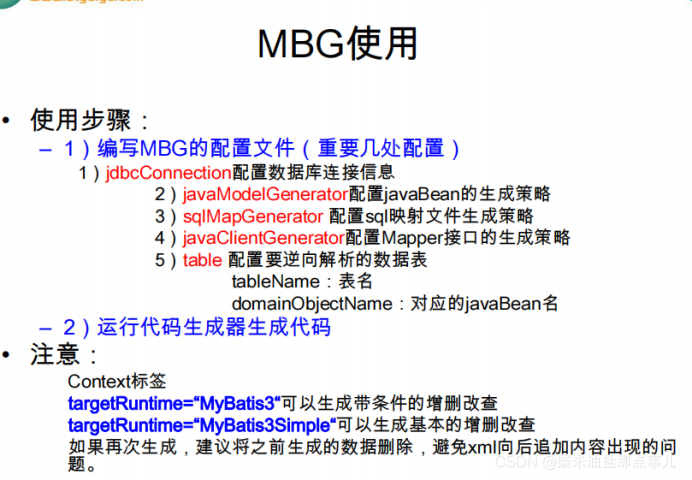
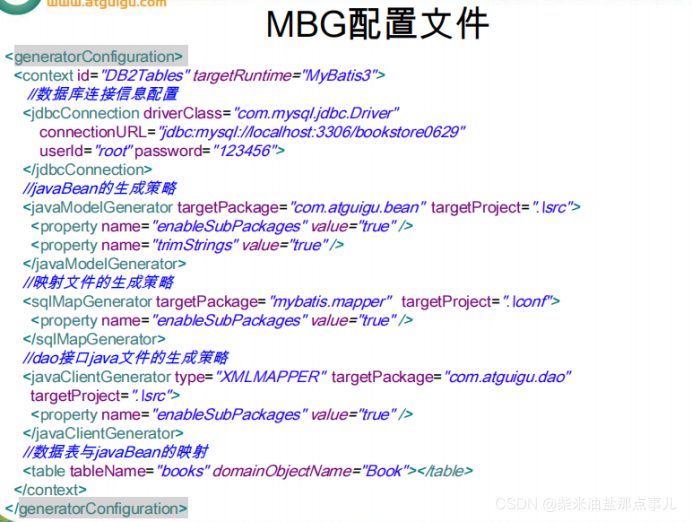
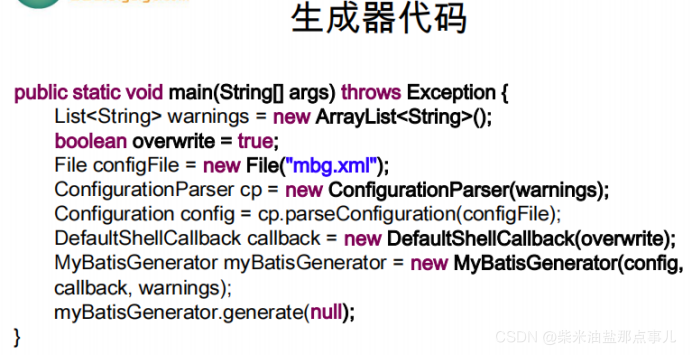

MyBatis-工作原理 这里太难,没有整理
MyBatis-插件开发-略
扩展:MyBatis实用场景-略
1)、PageHelper插件进行分页
• 2)、批量操作
• 3)、存储过程
• 4)、typeHandler处理枚举




 MyBatis作为流行的持久层框架,通过定制化SQL与映射简化JDBC编码,支持XML与注解配置,提升开发效率。本文涵盖MyBatis环境配置、插件机制及工作原理,展示其如何助力高效数据处理。
MyBatis作为流行的持久层框架,通过定制化SQL与映射简化JDBC编码,支持XML与注解配置,提升开发效率。本文涵盖MyBatis环境配置、插件机制及工作原理,展示其如何助力高效数据处理。
















 1323
1323

 被折叠的 条评论
为什么被折叠?
被折叠的 条评论
为什么被折叠?








